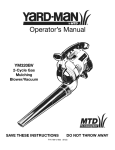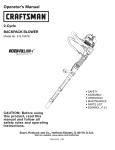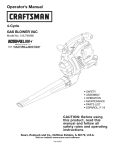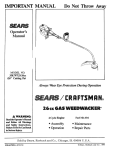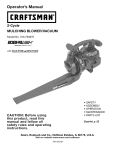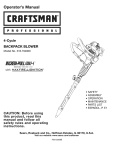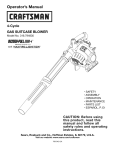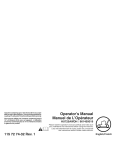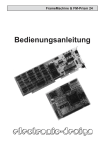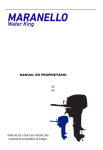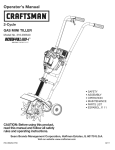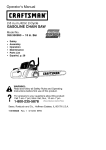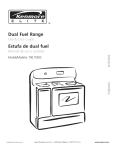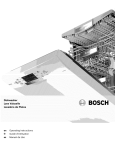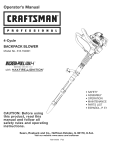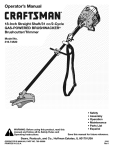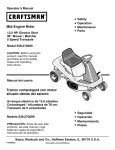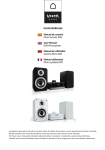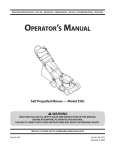Download Craftsman 316.79479 Blower User Manual
Transcript
Operator's
Manual
RN°
2-Cycle
BACKPACK BLOWER
Model No. 316.794790
INCREDI.PULL_
TM
UNBELIEVABLE
STARTING
E A S E _'_
•
•
•
•
•
•
SAFETY
ASSEMBLY
OPERATION
MAINTENANCE
PARTS LIST
ESPANOL, R 19
CAUTION:
Before using
this product, read this
manual and follow all
safety rules and operating
instructions.
Sears, Roebuck
and Co., Hoffman
Visit our website"
Estates, IL 60179, U.S.A.
www.sears.com/craftsman
769-03233
TABLE OF CONTENTS
Safety Rules .......................................
2
Warranty ..........................................
5
Know Your Unit .....................................
6
Assembly Instructions ................................
7
Oil and Fuel Information ..............................
9
Starting/Stopping
Instructions
........................
10
Operating Instructions ...............................
11
Maintenance and Repair Instructions ...................
12
Cleaning and Storage ...............................
14
Troubleshooting Chart ...............................
15
Specifications
.....................................
16
California Emission Control Warranty Statement
.......
17,18
Parts List ....................................
E20-E21
Service Numbers ...........................
Back Cover
SPARK ARRESTOR NOTE
NOTE: For users on U.S. Forest Land and in the states of
California, Maine, Oregon and Washington. All U.S. Forest Land
and the state of California (Public Resources Codes 4442 and
4443), Oregon and Washington require, by law that certain internal
combustion engines operated on forest brush and/or grass-covered
areas be equipped with a spark arrestor, maintained in effective
working order, or the engine be constructed, equipped and
maintained for the prevention of fire. Check with your state or local
authorities for regulations pertaining to these requirements. Failure
to follow these requirements could subject you to liability or a fine.
This unit is factory equipped with a spark arrestor. If it requires
replacement, ask your Sears or other qualified service dealer to
install the Accessory Part #753-05631 Muffler Assembly.
CALIFORNIA
PROPOSITION
The purpose of safety symbols is to attract your attention to possible
dangers. The safety symbols, and their explanations, deserve your
careful attention and understanding. The safety warnings do not by
themselves eliminate any danger. The instructions or warnings they
give are not substitutes for proper accident prevention measures.
SYMBOL
MEANING
caution. Attention is required in order to avoid serious
SAFETY injury.
personal
ALERT:
May be
Indicates
used in danger,
conjunction
warning
with orother
symbols or pictographs.
in serious injury to yourself or to others. Always follow
the
DANGER:
safety precautions
Failure to to
obey
reduce
a safety
the risk
warning
of fire,
willelectric
result
shock and personal injury.
result in injury to yourself and others. Always follow the
WARNING:
Failure
to obey the
a safety
can
safety precautions
to reduce
risk ofwarning
fire, electric
shock and personal injury.
,_
NOTE:
result in property damage or personal injury to yourself I
CAUTION:
Failure follow
to obey
safety precautions
warning mayto
or to others. Always
thea safety
reduce the r sk of f re, e ectr c shock and persona n ury.
Advises you of information or instructions vital to the
operation or maintenance of the equipment.
Read the Operator's Manual and follow all warnings and safety
instructions. Failure to do so can result in serious injury to the
operator and/or bystanders.
65 WARNING
FOR QUESTIONS,
CALL
1-800-4-MY-HOME
®
THE ENGINE EXHAUST FROM THIS PRODUCT CONTAINS
CHEMICALS KNOWN TO THE STATE OF CALIFORNIA TO
CAUSE CANCER, BIRTH DEFECTS OR OTHER
REPRODUCTIVE HARM.
• IMPORTANT SAFETY INSTRUCTIONS
READ ALL INSTRUCTIONS
BEFORE OPERATING
safety rules. Please read these instructions before operating
the unit in order to ensure the safety of the operator and any
bystanders. Please keep these instructions for later use.
• Read the instructions carefully. Be familiar with the controls and
proper use of the unit.
• Read this operating instruction manual carefully. Be thoroughly
familiar with the controls and the proper use of the equipment.
Know how to stop the unit and disengage the controls quickly.
• Do not operate this unit when tired, ill, or under the influence of
alcohol, drugs, or medication.
• Never allow children to operate the equipment. Never allow
adults unfamiliar with the instructions to use the unit. Never allow
adults to operate the equipment without proper instruction.
• All blower tubes must be installed properly before operating the unit.
•
SPECIAL SAFETY WARNINGS
FOR GAS ENGINES
vapors can explode if ignited. Take the following
WARNING:
Gasoline is highly flammable, and its
precautions:
• Store fuel only in containers specifically designed and approved
for the storage of such materials.
• Always stop the engine and allow it to cool before filling the fuel tank.
Never remove the cap of the fuel tank, or add fuel, when the engine
is hot. Never operate the unit without the fuel cap securely in place.
Loosen the fuel tank cap slowly to relieve any pressure in the tank.
• Add fuel in a clean, well-ventilated area outdoors where there are
no sparks or flames. Slowly remove the fuel cap only after
stopping engine. Do not smoke while fueling. Wipe up any spilled
fuel from the unit immediately.
• Avoid creating a source of ignition for spilled fuel. Do not start
the engine until fuel vapors dissipate.
• Move the unit at least 30 feet (9.1 m) from the fueling source and site
before starting the engine. Do not smoke. Keep sparks and open
flames away from the area while adding fuel or operating the unit.
WHILE
OPERATING
• Never start or run the unit inside a closed room or building,
Breathing exhaust fumes can kill. Operate this unit only in a wellventilated outdoor area.
• Wear safety glasses or goggles that are marked as meeting ANSI
Z87.1 standards and are marked as such. Wear ear/hearing
protection when operating this unit.
• Never run the unit without the the proper equipment attached,
• To reduce the risk of hearing loss associated with sound level(s),
always wear ear/hearing protection when operating this unit.
• Wear heavy long pants, boots, gloves, and a long sleeve shirt.
Do not wear loose clothing, jewelew, short pants, sandals or go
barefoot. Secure hair above shoulder level.
• To avoid static electricity shock, do not wear rubber gloves or
any other insulated gloves while operating this unit.
• Use the unit only in daylight or good artificial light.
• Keep outside surfaces free from oil and fuel.
• Avoid accidental starting. Be in the starting position whenever
pulling the starter rope. The operator and unit must be in a stable
position while starting. Refer to Starting/Stopping Instructions.
• Do not set unit on any surface except a clean, hard area while
engine is running. Debris such as gravel, sand, dust, grass, etc.
could be picked up by the air intake and thrown out by the
discharge opening, damaging unit, property, or causing serious
injury to bystanders or operator.
• Use the right tool. Only use this tool for its intended purpose.
• Do not force unit. It will do the job better and with less likelihood
of injury at a rate for which it was designed.
• Do not overreach or use from unstable surfaces such as ladders, trees,
steep slopes, rooftops, etc. Always keep proper footing and balance.
• Always hold the unit with a firm grip when operating.
• Keep hands, face, and feet away from all moving parts. Do not
touch or try to stop the impeller when it is rotating. Do not
operate without guards in place.
• Do not put any object into openings. Do not use with any
opening blocked; keep free of dirt, debris, and anything that may
reduce the air flow.
• Do not touch the engine or muffler. These parts get extremely
hot from operation, even after the unit is turned off.
• Do not operate the engine faster than the speed needed to do
the job. Do not run the engine at high speed when not in use.
• Always stop the engine when operation is delayed or when
walking from one location to another.
• Stop the engine for maintenance, repair, to install or remove the
blower tubes. The unit must be stopped and the impeller no
longer turning to avoid contact with the rotating blades.
• If you strike or come into contact with a foreign object, stop the engine
immediately and check for damage. Do not operate before repairing
damage. Do not operate the unit with loose or damaged parts.
• Use only replacement parts recommended for this tool that are
sold by a Sears outlet. Use of any replacement parts purchased
elsewhere may be hazardous, and will also void your warranty.
• Never use this unit for spreading chemicals, fertilizers or other
substances which may contain toxic materials.
• To reduce fire hazard, replace faulty muffler and spark arrestor.
Keep the engine and muffler free from grass, leaves, excessive
grease or carbon build up.
• Turn the engine off and disconnect the spark plug for maintenance
or repair.
• Never point the blower or blowing debris in the direction of people,
animals, or in the direction of windows. Always direct the blowing
debris away from people, animals, and windows. Use extra caution
when blowing debris near solid objects such as trees, automobiles,
walls, etc.
OTHER SAFETY WARNINGS
• Always disconnect the spark plug before performing maintenance
or accessing movable parts. See Replacing the Spark Plug.
• Never store the unit, with fuel in the tank, inside a building where
fumes may reach an open flame (pilot lights, etc.) or sparks
(switches, electrical motors, etc.).
• Allow the engine to cool before storing or transporting. Be sure
to secure the unit while transporting.
• Store the unit in a dry place, secured, or at a height to prevent
unauthorized use or damage. Keep out of the reach of children.
• Never douse or squirt the unit with water or any other liquid.
Keep handles dry, clean, and free from debris. Clean after each
use, see Cleaning and Storage instructions.
• Keep these instructions. Refer to them often and use them to
instruct other users. If you loan this unit to others, also loan
these instructions to them.
SPECIAL NOTE: Exposure to vibrations through prolonged use of
gasoline powered hand tools could cause blood vessel or nerve
damage in the fingers, hands, and joints of people prone to
circulation disorders or abnormal swelling. Prolonged use in cold
weather has been linked to blood vessel damage in otherwise
healthy people. If symptoms occur such as numbness, pain, loss
of strength, change in skin color or texture, or loss of feeling in the
fingers, hands or joints, discontinue use of this tool and seek
medical attention. A reduced vibration system does not guarantee
avoidance of these problems. Users who operate power tools on a
regular basis must closely monitor their physical condition and the
condition of this tool.
SAVE THESE
INSTRUCTIONS
SAFETY AND INTERNATIONAL
SYMBOLS
This operatorIs manual describes safety and international symbols and pictographs that may appear on this product.
manual for complete safety, assembly, operating, maintenance, and repair information.
SYMBOL
MEANING
SYMBOL
MEANING
• ON!OFF
• WEAR
EYE AND HEARING
WARNING:
STOP
CONTROL
STOP
CONTROL
|
or Caution. May be used in
•Indicates
SAFETY danger,
ALERT warning
SYMBOL
conjunction with other symbols or pictographs.
• WARNING:
READ OPERATOR'S
MANUAL
Read the 0perator!s manual(s) and follow all Warnings
and safety instructions. Failure to do so Can result in
serious injury to the operator and/or bystanders.
Read the operatorIs
I-
ON/OFF
V
PROTECTION
OFF or STOP
Thrown objects
• WARNING:
KEEP BYSTANDERS
AWAY and loud noise can
cause severe eye injury and hearing loss. Wear eye
protection meeting ANSI Z87.1 standards and ear
protection when operating this unit. Use a full face
shield when needed.
ThioWn 0bjects and loud noise can
Cause severe eye injury and hearing loss. Wear eye
protection meeting ANSI Z87:1 standards and ear
protection when operating this unit, Use a ful! face
shield when needed.
• THROWN OBJECTS CAN CAUSE SEVERE
INJURY
'=" _,
_'_
Always use Clean, fresh unleaded fuel.
• UNLEADED
FUEL
WARNING:
Thrown objects and loud noise can
cause severe eye injury and hearing loss. Wear eye
protection meeting ANSI Z87.1 standards and ear
protection when operating this unit. Use a full face
shield when needed.
L,_t_ _._ °OILRefer
manual for
'"_
_.
to operator s
the proper type of oil.
,
• HOT
,_!_/_
i
SURFACE
H N
WARNING
Do not touch a hot surface. You may get burned.
These parts get extremely hot from operation. They
remain hot for a short time after the unit is turned off.
3I"
CHOKE
CONTROL
1. • FULL choke position
2. • PARTIAL choke position
3. • BUN choke position
CRAFTSMAN TWO-YEAR FULL WARRANTY
If this Craftsman product fails due to a defect in material or workmanship within two years from the date of purchase, return it to any Sears store,
Parts and Repair Service Center, or other Craftsman outlet for free repair (or replacement if repair proves impossible). This warranty does not include:
• Expendable items which can wear out from normal use within the warranty period, such as cutting line, air cleaner or spark plug.
• Repairs necessary because of operator abuse or negligence and failure to operate or maintain the product according to all supplied instructions.
This warranty applies for only 90 days from the date of purchase if this product is ever used for commercial or rental purposes. This warranty
applies only while this product is used in the United States. This warranty gives you specific legal rights, and you may also have other rights
which vary from state to state.
Sears, Roebuck and Co., Hoffman Estates, IL 60179
Repair Protection Agreements
Congratulations on making a smart purchase. Your new Craftsman® product is designed and manufactured for years of dependable operation. But
like all products, it may require repair from time to time. That's when having a Repair Protection Agreement can save you money and aggravation.
Here's what the Repair Protection Agreement* includes:
Expert service by our 10,000 professional repair specialists
Unlimited service and no charge for parts and la-bor on all covered repairs
Product replacement up to $1500 if your covered product can't be fixed
Discount of 10% from regular price of service and related installed parts not covered by the agreement; also, 10% off regular price of
preventive maintenance check
Fast help by phone - we call it Rapid Resolution - phone support from a Sears representative. Think of us as a "talking owner's manual."
Once you purchase the Repair Protection Agreement, a simple phone call is all that it takes for you to schedule service. You can call
anytime day or night, or schedule a service appointment online.
The Repair Protection Agreement is a risk-free purchase. If you cancel for any reason during the product warranty period, we will provide a
full refund. Or, a prorated refund any time after the product warranty period expires. Purchase your Repair Protection Agreement today!
Some limitations and exclusions apply. For prices and additional information in the U.S.A. call 1-800-827-6655.
*Coverage in Canada varies on some items. For full details call Sears Canada at 1-800-361-6665.
For Sears professional installation of home appliances,
Canada call 1-800-4-MY-HOME ®.
Sears Installation Service
garage door openers, water heaters, and other major home items, in the U.S.A. or
Air Filter Cover
Starter Rope
Handle
Choke Lever
Fuel Cap
Suspension System
Stand
Shoulder Support
Buckle
Trigger Lock
Waist Support
Throttle
Cables
Waist
Support
Clip
Throttle Grip
Flex Tube
Trigger
Muffler
Primer Bulb
Blower
Tube
J
Fuel Tank
Nozzle
ASSEMBLING
THEBLOWER
TUBE
damage to the unit, shut the unit off before removing
installing the blower tubes.
WARNING:
Toavoid
serious
personal
iojuandor
Installing the Flex Tube
1.
2.
3.
4.
Place a hose clamp over the end of the Flex Tube (Fig. 1A).
Slide the end of the Flex Tube with the clamp on it over the
elbow tube (Fig. 1B).
Align the bump on the Flex Tube with the bump on the elbow
tube (Fig. 1C).
Tighten the screw on the hose clamp to secure the Flex Tube
to the elbow tube (Fig. 1D).
Installing the Lower Blower Tubes and Nozzle
1. Align the bump slot on the end of the first lower blower tube
with the bump on the bottom end of the upper blower tube
(Fig. 3, A).
2.
Insert the bump on the upper blower tube into the bump slot
on the tube extension (Fig. 3, A).
3. Twist the extension tube as shown around the upper upper blower
tube until the handle tube bump locks into place (Fig. 3, B).
B
A
B
A
Fig. 3
4.
5.
Fig. 1
Installing the Upper Blower Tube
1. Place a hose clamp over the other end of the Flex Tube (Fig. 2, A).
2.
Slide the end of the hose with the clamp on it over the top end
of the upper blower tube (Fig. 2, B).
3.
Align the bump on the Flex Tube with the bump on the upper
blower tube (Fig. 2, C).
Tighten the screw on the hose clamp to secure the Flex Tube
to the upper blower tube (Fig. 2, D).
4.
6.
Align the bump slot on the end of the second lower blower tube with
the bump on the bottom end d the first lower blower tube (Fig. 4, A).
Insert the bump on the first lower blower tube into the bump
slot on the second lower blower tube (Fig. 4, A).
Twist the second lower blower tube as shown around the first
lower blower tube until the second lower blower tube bump
locks into place (Fig. 4, B).
B
A
Fig. 4
7.
Align the bump slot on the top end of the nozzle with the bump
on the bottom end of the second lower blower tube (Fig. 5, A).
8.
Insert the bump on the second lower blower tube into the
bump slot on the nozzle (Fig. 5, A).
Twist the nozzle as shown around the second lower blower tube
until the nozzle bump locks into place (Fig. 5, B).
A
g
9.
c
Fig. 2
Fig. 5
The completed blower tube should look like Figure 6.
Elbow Tube
Zip Tie
Secure the Throttle Cables
Place a zip tie around the elbow tube and the throttle cables (Fig.
7) as shown, making sure not to crimp the cables.
Hose Clamp
t/
Zip Tie._
Flex Tube
Throttle Cables
Hose Clamp
Zip Tie
Fig. 7
On/Off Switch
Upper Blower Tube
Throttle Grip
Adjusting the Handle
1. Rotate the throttle grip counterclockwise
around the blower
tube until it is pointing directly downward (Fig. 8, A).
I _IIL
adjust. This may cause the throttle cables to
WARNING:
rotate grip
the or
handle
clockwise to
disconnect fromDo
thenot
throttle
the engine.
First Lower
Blower Tube
A
Second Lower
Blower Tube
2.
3.
Pull or push the throttle grip along the handle tube until its
distance from the backpack blower is comfortable (Fig. 8, B).
Align the throttle grip with the slot closest to the comfortable
place and rotate the throttle grip clockwise into the upright
position (Fig. 9).
Nozzle
Fig. 6
I_bk
sure that all four parts of the blower tube are locked in
place or firmly installed.
WARNING:
To avoid serious personal injury, make
Fig. 9
OIL AND FUEL MIXING INSTRUCTIONS
Old and/or improperly mixed fuel are the main reasons for the unit
not running properly. Be sure to use fresh, clean unleaded fuel.
Follow the instructions carefully for the proper fuel/oil mixture.
Definition of Blended Fuels
Today's fuels are often a blend of gasoline and oxygenates such as
ethanol, methanol, or MTBE (ether). Alcohol-blended fuel absorbs
water. As little as 1% water in the fuel can make fuel and oil
separate. It forms acids when stored. When using alcohol-blended
fuel, use fresh fuel (less than 60 days old).
Using Blended Fuels
If you choose to use a blended fuel, or its use is unavoidable,
follow recommended precautions:
• Always use the fresh fuel mix explained in your operator's
manual
• Always agitate the fuel mix before fueling the unit
• Drain the tank and run the engine dry before storing the unit
Using Fuel Additives
reliability, pay strict attention to the oil and fuel mixing
instructions
the proper
2-cycleengine
oil container.
Using
I_
AUTION: on For
operation
and improperly
maximum
m xed fue can severey damage the eng ne.
The bottle of 2-cycle oil that came with your unit contains a fuel
additive which will help inhibit corrosion and minimize the formation
of gum deposits. It is recommended that you use our 2-cycle oil
with this unit. If unavailable, use a good 2-cycle oil designed for
air-cooled engines along with a fuel additive, such as STA-BIL®
Gas Stabilizer or an equivalent. Add 0.8 oz. (23 ml.) of fuel additive
per gallon of fuel according to the instructions on the container.
NEVER add fuel additives directly to the unit's fuel tank.
Thoroughly mix the proper ratio of 2-cycle engine oil with unleaded
gasoline in a separate fuel can. Use a 40:1 fuel/oil ratio. Do not mix
them directly in the engine fuel tank. See the table below for
specific gas and oil mixing ratios.
NOTE: One gallon (3.8 liters) of unleaded gasoline mixed with one
3.2 oz. (95 ml.) bottle of 2-cycle oil makes a 40:1 fuel/oil
ratio.
NOTE: Dispose of the old fuel/oil mix in accordance to Federal,
State and Local regulations.
WARNING:
Gasoline is extremely flammable. Ignited
vapors may explode. Always stop the engine and allow
it to cool before filling the fuel tank. Do not smoke while I
filling the tank. Keep sparks and open flames at a
d stance from the area.
WARNING:
Add fuel in a clean, well ventilated
J
outdoor area. Wipe up any spilled fuel immediately.
Avoid creating a source of ignition for spilt fuel. Do not
start the engine until fuel vapors dissipate.
I
FUELING THE UNIT
from fuel spray. Never operate the unit without the fuel
WARNING:
fuel cap slowly to avoid injury
cap securely in Remove
place.
I_
1.
2.
Remove the fuel cap.
Place the gas container's spout into the fill hole on the fuel
tank (Fig. 10) and fill the tank.
f_
Gas Can
Spout
Fuel Tank
Fig. 10
NOTE: Do not overfill the tank.
3. Wipe up any fuel that may have spilled.
4. Reinstall the fuel cap.
5. Move the unit at least 30 ft. (9.1 m) from the fueling source
and site before starting the engine.
I
NOTE:
UNLEADED GAS
2-CYCLE
OIL
1 GALLON US
(3.8 LITERS)
3.2 FL OZ.
(95 ml)
1 LITER
25 ml
MIXING RATIO - 40:1
Dispose of any old fuel mixture in accordance
State and Local regulations.
to Federal,
On/Off
ventilated
outdoor
area.Carbon
monoxide
exhaust
WARNING:Operate
thisunitoanly
ina wellfumescanbelethalinaconfined
rea.
Trigger_
WARNING:
Avoid accidental starting. Make sure
you are in the starting position when pulling the starter
rope (Fig. 12). To avoid serious injuw, the operator and
unit must be in a stable position while starting.
To avoid serious personal injuw, make sure that the
blower tube is locked in place or firmly installed.
Switch
>
,oc.
Trigger _
\\
\
\
STARTING INSTRUCTIONS
1.
Mix gas with oil. Fill fuel tank with fuel/oil mixture. See Oil
and Fuel Mixing Instructions.
NOTE: There is no need to turn the unit on. The On/Off
Switch is in the ON ( I ) position at all times (Fig. 11A).
......
2.
Fully press and release the primer bulb 10 times, slowly.
Some amount of fuel should be visible in the primer bulb
and fuel lines (Fig. 12). If you can't see fuel in the bulb,
press and release the bulb as many times as it takes until
you can see fuel in it.
3.
Place the choke lever in Position 1 (Fig. 12).
,
4.
Squeeze and hold the trigger (Fig. 11A).
5.
Press and hold the trigger lock (Fig. 11B).
6.
Release the trigger.
'
7.
Release the trigger lock to lock the trigger.
'.......NOTE: The trigger lock should hold the trigger in the pressed
position (Fig. 11B). If not, repeat steps 4-7.
Crouch in the starting position (Fig. 13) and pull the starter
rope out with a controlled and steady motion 5 times.
9.
Place the choke lever in Position 2 (Fig. 12).
10. Pull the starter rope out with a controlled and steady
motion until the engine starts.
11. Keep the trigger locked and allow the engine to warm up
for 15 to 30 seconds.
NOTE: Engine may take longer to warm up and reach
maximum operating speed at colder temperatures.
NOTE: Unit is properly warmed up when engine accelerates
without hesitation. To accelerate, squeeze and release
the trigger to deactivate the trigger lock (Fig. 11, B), then
squeeze the trigger for desired acceleration.
12. Once the engine is warmed up, place the choke lever in
Position 3 (Fig. 12). The unit is ready for use.
13. If desired, activate the trigger lock.
NOTE: The trigger lock locks the trigger in the operating
position (Fig. 11 B) to facilitate starting the unit and to
make continuous operation easier. To lock the
trigger, follow steps 4-7 above. To release the trigger
lock, squeeze the trigger firmly, then release. The
lock should disengage and allow the trigger to return
to the idle position (Fig. 11A).
IF... the engine hesitates, return the choke lever to Position 2
(Fig. 12) and continue warm-up.
IF... the engine does not start, go back to step 2.
IF... the engine fails to start after a few attempts, place the
choke lever in Position 3, and squeeze and lock the trigger.
Pull the starter rope with a controlled and steady motion
3 to 8 times. The engine should start. If not, repeat.
IF WARM... If the engine is already warm, make sure the
On/Off Stop control is in the ON position. Place the
choke lever in Position 2 and pull the starter rope. After
the unit starts, move the choke lever to Position 3.
Fig. 11A
Fig. 11B
8.
Primer
Bulb
Fig. 12
Starter
Rope
STOPPING INSTRUCTIONS
1.
Release your hand from the trigger. Allow the engine to cool
down by idling.
2.
Press the On/Off Stop Control switch in the OFF (O) position
and hold until the engine comes to a complete stop (Fig. 11A).
Fig. 13
ADJUSTING
THESUSPENSION
SYSTEM
1.
2.
Place the unit's shoulder supports over your shoulders while
the unit is behind you.
Close the suspension system's waist support by sliding the
waist support clips together (Fig. 14, A).
A
Fig. 17
Fig. 14
NOTE:
Make sure the weight of the unit is supported
by the waist support (Fig. 15, A).
on the hips
glasses or goggles, ear/hearing protection, gloves, long pants
and long sleeve shirt.
• If the conditions are dusty, the operator is wearing a dust mask
or face mask.
• The unit is in good working condition.
• The tubes are in place and secure.
OPERATING TIPS
I_
damage to the unit, make sure blower tubes are in
ARNING:
prevent the
serious
place
before youTooperate
unit. personal injury or
B
Fig. 15
3.
If weight is not on hips, loosen the shoulder supports (Fig. 16,
A) and pull the waist support handle (Fig. 15, B) to tighten.
Adjust until the unit's weight rests on the hips.
B
A
Fig. 16
4.
Pull the shoulder support handles to tighten the shoulder
supports (Fig. 14, B).
Releasing the Suspension System
1. To release the shoulder supports, pull up on bottom tab of the
shoulder support buckles (Fig. 16, A).
2. Squeeze the top and bottom of the waist support clips to
release the waist support (Fig. 16, B).
HOLDING THE BLOWER
I_
goggles or safety glasses at all times when operating
this unit. Wear a face mask or dust mask in dusty
ARNING:
To avoid serious personal injury, wear
locations.
Before operating the unit, stand in the operating position (Fig. 17).
Check for the following:
• Operator is wearing proper clothing, such as boots, safety
10
• Assure the unit is not directed at anybody or any loose debris
before starting the unit.
• Verify that the unit is in good working condition. Make sure the
tubes are in place and secure.
• Always hold the unit securely when operating.
• To reduce the risk of hearing loss associated with sound level(s),
hearing protection is required.
• Operate power equipment only at reasonable hours-- not early in the
morning or late at night when people might be disturbed. Comply
with times listed in local ordinances. Usual recommendations are 9:00
am to 5:00 pm, Monday through Saturday.
• To reduce noise levels, limit the number of pieces of equipment
used at any one time.
• To reduce noise levels, operate power blowers at the lowest
possible speed to do the job.
• Check your equipment before operation, especially the muffler,
air intakes and air filters.
• Use rakes and brooms to loosen debris before blowing.
• In dusty conditions, slightly dampen surfaces.
• Conserve water by using power blowers instead of hoses for
many lawn and garden applications, including areas such as
screens, patios, grills, porches, and gardens.
• Watch out for children, pets, open windows or freshly washed
cars, and blow debris safely away.
• Use the full blower nozzle extension so the air stream can work
close to the ground.
• Clean up after using blowers and other equipment. Dispose of
debris appropriately.
• Use the trigger lock (Fig. 11, B) to keep the trigger depressed
while operating to make continuous operation easier.
APPLICATIONS
1
Use the blower for trees, shrubs, flower beds and hard-to-clean areas.
2.
Use the unit around buildings and for other normal cleaning
procedures.
3.
Use the blower around walls, overhangs, fences and screens.
WARNING"
To prevent serious injury, never perform
maintenance or repairs with unit running. Always
service and repair a cool unit, Disconnect the spark
plug wire to ensure that the unit cannot start. See
Replacing the Spark Plug.
MAINTENANCE
SCHEDULE
Air Filter
Locking Tab
Back Plate
Perform these required maintenance procedures at the frequency
stated in the table, These procedures should also be a part of any
seasonal tune-up.
NOTE: Some maintenance procedures may require special tools
or skills. If you are unsure about these procedures take
your unit to a Sears or other qualified service dealer.
NOTE: Maintenance, replacement, or repair of the emission
control devices and system may be performed by a Sears
or other qualified service dealer.
In order to assure peak performance of your engine, inspection of
the engine exhaust port may be necessary after 50 hours of
operation, If you notice lost RPM, poor performance or general lack
of acceleration, this service may be required. If you feel your engine
is in need of this inspection, refer service to a Sears or other
qualified service dealer for repair. DO NOT attempt to perform this
process yourself as engine damage may result from contaminants
involved in the cleaning process for the port.
FREQUENCY
MAINTENANCE REQUIRED
SEE
Before using
Fill fuel tank with fresh fuel
p 8
Every 25 hrs
Clean and re-oil air filter
Check spark plug condition and gap
p 11
p 12
Every 50 hrs
Clean spark arrestor
p 12
Fig. 19
Fig. 21
Fig. 20
AIR FILTER MAINTENANCE
Cleaning the Air Filter
Clean and re-oil the air filter every 25 hours of operation, It is an important
item to maintain. Failure to maintain your air filter properly can result in
poor performance or can cause permanent damage to your engine,
1. Open the air filter cover. Push the locking tab on the top of the
cover inward, then pull the air filter cover out and down. (Fig. 18),
_ Locking
Ai(_Filter
Fig. 22
Locking Tab
Fig. 18
2.
3,
Remove the air filter (Fig. 19).
Wash the filter in detergent and water (Fig, 20). Rinse the filter
thoroughly and allow it to dry.
4. Apply enough clean SAE 30 motor oil to lightly coat the filter
(Fig, 21).
5. Squeeze the filter to spread and remove excess oil (Fig. 22),
6, Replace the filter (Fig. 19).
NOTE: If the unit is operated without the air filter, you will VOID
the warranty.
7, Reinstall the air filter cover. Position the slots on the bottom of
the air filter cover onto the tabs at the bottom of the back plate
(Figs. 19),
8, Swing the cover up until the tab on the air filter backplate
snaps into place in the slot on the air filter cover (Fig. 23).
Air Filter
Cover
Fig. 23
11
CARBURETOR
ADJUSTMENT
The idle speed of the engine is adjustable. An idle adjustment screw
is between the air filter cover and the engine starter housing (Fig. 24).
Remove
Screws
Remove
Screws
Idle Adjustment
Screw
Fig. 25
4.
Fig. 24
NOTE:
Careless adjustments can seriously damage your unit. An
authorized service dealer should make carburetor adjustments.
Check Fuel
Old and!or improperly mixed fuel is usually the reason for improper unit
performance. Drain and refill the tank with fresh, properly-mixed fuel
prior to making any adjustments. Refer to Oil and Fuel Information.
Clean Air Filter
The condition of the air filter is important to the operation of the unit.
A dirty air filter will restrict air flow. This is often mistaken for an out
of adjustment carburetor. Check the condition of the air filter before
adjusting the idle speed screw. Refer to Air Filter Maintenance.
Adjust Idle Speed Screw
If, after checking the fuel and cleaning the air filter, the engine still
will not idle, adjust the idle speed screw as follows:
1. Start the engine and let it run at a high idle for a minute to
warm up. Refer to Starting/Stopping
Instructions.
2. Release the trigger lock and let the engine idle. If the engine
stops, insert a small phillips in between the Air Filter Cover
and the Engine Cover (Fig. 24). Turn the idle speed screw in,
clockwise, 1/8 of a turn at a time (as needed) until the engine
idles smoothly.
Checking the fuel mixture, cleaning the air filter, and adjusting the
idle speed should solve most engine problems. If not and all of the
following are true:
• the engine will not idle
• the engine hesitates or stalls on acceleration
• there is a loss of engine power
Have the carburetor adjusted by an authorized service dealer.
REPLACING THE SPARK PLUG
Use a Champion #RDZ4H or a replacement part #753-05784 spark
plug. The correct air gap is 0.025 in. (0.635 mm.). Remove the plug
after every 25 hours of operation and check its condition.
1. Stop the engine and allow it to cool. Remove the four (4)
screws on the back of the engine cover with a Flat-head or T25 Torx screwdriver (Fig. 25).
2. Grasp the plug wire firmly and pull the cap from the spark plug.
3. Clean dirt from around the spark plug. Remove the spark plug from
the cylinder head by turning a 5/8 in. socket counterclockwise.
WARNING:
Do not sand blast, scrape or clean
electrodes. Grit in the engine could damage the
cylinder.
12
Replace cracked, fouled or dirty
spark plug. Set the air gap at
0.025 in. (0.635 mm.) using a
feeler gauge (Fig. 26).
0.025 in.
5.
Install a correctly-gapped
spark
plug in the cylinder head. Turn
the 5/8 in. socket clockwise
(0.635,_mm.)
_
,
until snug.
If using a torque wrench torque to:
110-120 in.•lb. (12.3-13.5 N•m)
Fig. 26
Do not over tighten.
SPARK ARRESTOR MAINTENANCE
Inspect the spark arrestor after every 50 hours of operation.
1. Remove the rear engine cover (Fig. 25).
2. With a flat blade screwdriver or Torx T-25 bit, remove the 2
screws attaching the muffler to the engine (Fig. 27).
3"-25 Screws
Muffler
Fig. 27
3.
With a flat blade screwdriver or Torx T-20 bit, remove the screw
attaching the spark arrestor cover to the muffler (Fig. 28).
3"-20 Screw
Spark
Arrestor
Spark Arrestor Cover
Fig. 28
4.
5.
Remove the spark arrestor cover.
Remove the spark arrestor screen from the spark arrestor cover
(Fig. 28).
6. Clean the spark arrestor screen with a wire brush or replace it.
7. Reinstall the spark arrestor screen, spark arrestor cover and screws.
CLEANING
IA
turn your unit off and allow it to cool before you clean
WARNING"
To avoid serious personal injury, always
or service it.
Use a small brush to clean off the outside of the unit. Do not use strong
detergents. Household cleaners that contain aromatic oils such as pine
and lemon, and solvents such as kerosene, can damage plastic housing
or handle. Wipe off any moisture with a soft cloth.
STORAGE
• Never store the unit with fuel in the tank where fumes may reach
an open flame or spark.
• Allow the engine to cool before storing.
• Lock up the unit to prevent unauthorized use or damage.
• Store the unit in a dry, well-ventilated area.
• Store the unit out of the reach of children.
LONG TERM STORAGE
If you plan on storing the unit for an extended time, use the
following storage procedure:
1. Drain all fuel from the fuel tank into a container with the same
2-cycle fuel mixture. Do not use fuel that has been stored for
more than 60 days. Dispose of the old fuel/oil mix in
accordance to Federal, State and Local regulations.
2. Start the engine and allow it to run until it stalls. This ensures
that all fuel has been drained from the carburetor.
3. Allow the engine to cool. Remove the spark plug and put 1 oz.
(30 ml) of any high quality motor oil or 2-cycle oil into the
cylinder. Pull the starter rope slowly to distribute the oil.
Reinstall the spark plug.
NOTE: Remove the spark plug and drain all of the oil from the
cylinder before attempting to start the trimmer after
storage.
4. Thoroughly clean the unit and inspect it for any loose or
damaged parts. Repair or replace damaged parts and tighten
loose screws, nuts or bolts. The unit is ready for storage.
TRANSPORTING
• Allow the engine to cool before transporting
• Drain fuel from unit
• Tighten fuel cap before transporting
• Secure the unit while transporting
13
CAUSE
ACTION
Empty fuel tank
Fill fuel tank with properly mixed fuel
Old or improperly mixed fuel
Drain gas tank and add fresh fuel mixture
Plugged spark arrestor
Clean or replace spark arrestor
CAUSE
ACTION
Air filter is plugged
Improper carburetor
Replace or clean the air filter
adjustment
Adjust according to the Carburetor Adjustments section or take to
a Sears or other qualified service dealer for an adjustment
CAUSE
ACTION
Old or improperly mixed fuel
Drain gas tank and add fresh fuel mixture
Dirty air filter
Clean or replace the air filter
CAUSE
ACTION
Old or improperly mixed fuel
Drain gas tank and add fresh fuel mixture
Fouled spark plug
Replace or clean the spark plug
HELP?
14
ii
Engine
Type...................................................................................................................................................................
Air-Cooled,
2-Cycle
Displacement
..................................................................................................................................................................
1.55cuin.(25.4cc)
IdleSpeedRPM..............................................................................................................................................................
3,800-4,200
rpm
Operating
RPM...............................................................................................................................................................
7,400-7,800
rpm
MPH............................................................................................................................................................................
150-175
CFM............................................................................................................................................................................
350-400
Ignition
Type...................................................................................................................................................................
Electronic
Ignition
Switch
................................................................................................................................................................
Rocker
Switch
SparkPlugGap...............................................................................................................................................................
0.025in.(0.635
mm)
Lubrication
....................................................................................................................................................................
Fuel/Oil
Mixture
Fuel/Oil
Ratio
..................................................................................................................................................................
40:1
Carburetor
.....................................................................................................................................................................
Diaphragm,
All-Position
Starter
..........................................................................................................................................................
SpringAssistStartingAuto Rewind
TM
Muffler .......................................................................................................................................................................................
Throttle .................................................................................................................................................................................
Fuel Tank Capacity ...........................................................................................................................................................................
*All specifications are based on the latest product
time without notice.
CALIFORNIA
information
Baffled with Guard
Manual Spring Return
20 oz. (591 ml)
available at the time of printing. We reserve the right to make changes at any
/ EPA EMISSION
CONTROL
WARRANTY
STATEMENT
Your Warranty Rights and Obligations
The California Air Resources Board, the Environmental Protection Agency, and Sears Brands LLC (Sears) are pleased to explain the emission
control system warranty on your 2007 and later small off-road engine. In California and the 49 states, new small off-road engines must be
designed, built and equipped to meet the state's stringent anti-smog standards. Sears must warrant the emission control system on your small offroad engine for the periods of time listed below provided there has been no abuse, neglect or improper maintenance of your small off-road engine.
Your emission control system may include parts such as the carburetor or fuel-injection
Also included may be hoses, belts, connectors and other emission-related assemblies.
Where a warrantable
system, the ignition system, and catalytic converter.
condition exists, Sears will repair your small off-road engine at no cost to you including diagnosis, parts and labor.
The 2007 and later small off-road engines are warranted for two years. If any emission-related
repaired or replaced by Sears.
part on your engine is defective, the part will be
Owners Warranty Responsibilities
As the small off-road engine owner, you are responsible for the performance of the required maintenance listed in your operator's manual.
Sears recommends that you retain all receipts covering maintenance on your small off-road engine, but Sears cannot deny warranty solely
for the lack of receipts or for your failure to ensure the performance of all scheduled maintenance.
• As the small off-road engine owner, you should however be aware that Sears may deny you warranty coverage if your small off-road
engine or a part has failed due to abuse, neglect, improper maintenance or unapproved modifications.
• You are responsible for presenting your small off-road engine to a Sears Authorized Service Center as soon as a problem exists. The
warranty repairs should be completed in a reasonable amount of time, not to exceed 30 days.
If you have any questions regarding your warranty rights and responsibilities,
•
•
•
•
•
•
•
•
•
you should call 1-800-4-MY-HOME
®.
Manufacturer's Warranty Coverage
The warranty period begins on the date the engine or equipment is delivered to the retail purchaser.
The manufacturer warrants to the initial owner and each subsequent purchaser, that the engine is free from defects in material and
workmanship which cause the failure of a warranted part for a period of two years.
Repair or replacement of warranted part will be performed at no charge to the owner at an Authorized Sears Service Center. For the
nearest location please contact Sears at: 1-800-4-MY-HOME
®.
Any warranted part which is not scheduled for replacement, as required maintenance or which is scheduled for only for regular inspection
to the effect of "Repair or Replace as Necessary" is warranted for the warranty period. Any warranted part which is scheduled for
replacement as required maintenance will be warranted for the period of time up to the first scheduled replacement point for that part.
The owner will not be charged for diagnostic labor which leads to the determination that a warranted part is defective, if the diagnostic
work is performed at an Authorized Sears Service Center.
The manufacturer is liable for damages to other engine components caused by the failure of a warranted part still under warranty.
Failures caused by abuse, neglect or improper maintenance are not covered under warranty.
The use of add-on or modified parts can be grounds for disallowing a warranty claim. The manufacturer is not liable to cover failures of
warranted parts caused by the use of add-on or modified parts.
In order to file a claim, go to your nearest Authorized Sears Service Center. Warranty services or repairs will be provided at all Authorized
Sears Service Centers.
• Any manufacturer approved replacement part may be used in the performance of any warranty maintenance or repair of emission related
parts and will be provided without charge to the owner. Any replacement part that is equivalent in performance or durability may be used
in non-warranty maintenance or repair and will not reduce the warranty obligations of the manufacturer.
Emission Warranty Parts List:
The following components are included in the emission-related warranty of the engine: air filter, carburetor, primer, fuel lines, fuel pick up/fuel
filter, ignition module, spark plug, and muffler. Valves and Cam are additionally included if your engine is a 4-Stroke Model.
15
CALIFORNIA
EVAPORATIVE
EMISSION
CONTROL
WARRANTY
STATEMENT
Your Warranty Rights and Obligations
The California Air Resources Board and Sears Brands LLC (Sears) is pleased to explain the evaporative emission control system's warranty
on your 2007 model year and later small off-road (equipment type) engine. In California, new equipment that use small off-engines must be
designed, built, and equipped to meet the State's stringent anti-smog standards Sears must warrant the evaporative emission control
system on your small off-road Lawn & Garden engine for the period listed below provided there has been no abuse, neglect or improper
maintenance of your equipment.
Your evaporative emission control system may include parts such as: carburetors, fuel tanks, fuel lines, fuel caps, valves, canisters, filters,
vapor hoses, clamps, connectors, and other associated components.
For engines less than or equal to 80 cc, only the fuel tank is subject
to the evaporative emission control warranty requirements of this section. The displacement of your small off road engine is less than 80 cc.
Manufacturer's Warranty Coverage
This evaporative emission control system is warranted for two years. If any evaporative emission-related part on your equipment is defective,
the part will be repaired or replaced by Sears.
Owner's Warranty Responsibilities
• As the small off-road Lawn & Garden engine owner, you are responsible for performance of the required maintenance listed in your owner's
manual. Sears recommends that you retain all receipts covering maintenance on your Lawn & Garden Engine but Sears cannot deny
warranty solely for the lack of receipts.
• As the small off-road Lawn & Garden engine owner, you should however be aware that the Sears may deny you warranty coverage if your
fuel tank has failed due to abuse, neglect, or improper maintenance or unapproved modifications.
• You are responsible for presenting your Lawn & Garden fuel tank to Sears distribution center or service center as soon as the problem
exists. The warranty repairs should be completed in a reasonable amount of time, not to exceed 30 days. If you have a question
regarding your warranty coverage, you should contact Sears at 1-800-4-MY-HOME
®.
Defects Warranty Requirements
(a) The warranty period begins on the date the engine or equipment is delivered to an ultimate purchaser.
(b) General Evaporative Emissions Warranty Coverage. The fuel tank must be warranted to the ultimate purchaser and any subsequent
owner that the evaporative emission control system when installed was:
(1) Designed, built, and equipped so as to conform with all applicable regulations; and
(2) Free from defects in materials and workmanship that causes the failure of a warranted part for a period of two years.
(c) The warranty on evaporative emissions-related parts will be interpreted as follows:
(1) Any warranted part that is not scheduled for replacement as required maintenance in the written instructions must be warranted for the
warranty period defined in subsection (b)(2). If any such part fails during the period of warranty coverage, it must be repaired or replaced
by Sears. Any such part repaired or replaced under the warranty must be warranted for a time not less than the remaining warranty period.
(2) Any warranted part that is scheduled only for regular inspection in the written instructions must be warranted for the warranty period
defined in subsection (b)(2). A statement in such written instructions to the effect of "repair or replace as necessary" will not reduce the
period of warranty coverage. Any such part repaired or replaced under warranty must be warranted for a time not less than the
remaining warranty period.
(3) Any warranted part that is scheduled for replacement as required maintenance in the written instructions must be warranted for the period of
time prior to the first scheduled replacement point for that part. If the part fails prior to the first scheduled replacement, the part must be
repaired or replaced by the Sears. Any such part repaired or replaced under warranty must be warranted for a time not less than the
remainder of the period prior to the first scheduled replacement point for the part.
(4) Repair or replacement of any warranted part under the warranty provisions of this article must be performed at no charge to the owner
at a warranty station.
(5) Not withstanding the provisions of subsection (4) above, warranty services or repairs must be provided at distribution centers that are
franchised to service the subject engines or equipment.
(6) The owner must not be charged for diagnostic labor that leads to the determination that a warranted part is in fact defective, provided
that such diagnostic work is performed at a warranty station.
(7) Throughout the evaporative emission control system's warranty period set out in subsection (b)(2), Sears must maintain a supply of
warranted parts sufficient to meet the expected demand for such parts.
(8) Manufacturer approved replacement parts must be used in the performance of any warranty maintenance or repairs and must be
provided without charge to the owner. Such use will not reduce the warranty obligations of the manufacturer issuing the warranty.
(9) The use of any add-on or modified parts will be grounds for disallowing a warranty claim made in accordance with this article. The
manufacturer issuing the warranty will not be liable under this Article to warrant failures of warranted parts caused by the use of an
add-on or modified part.
(10) Sears shall provide any documents that describe the warranty procedures or policies within five working days of request by the Air
Resources Board.
Emission Warranty Parts List
(1) Fuel Tank
Written instructions for the maintenance and use of the evaporative emissions control system by the owner shall be furnished with each
new engine or equipment.
16
Manual
del Operador
RN°
2-Ciclos
SOPLADOR
DE MOCHILA
Modelo No. 316.794790
INCREDI.PULL_
T_
UNBELIEVABLE
STARTING
E A S E _'_
•
•
•
•
•
SEGURIDAD
MONTAJE
FUNCIONAMIENTO
MANTENIMIENTO
LISTADO DE PIEZAS
PRECAUCION:
Antes de
utilizar este producto,
lea
este manual y siga todas
las reglas de seguridad
y
las instrucciones
de
funcionamiento.
Sears, Roebuck
and Co., Hoffman
Visit our website"
Estates, IL 60179, U.S.A.
www.sears.com/craftsman
769-03233
INDICE DE CONTENIDOS
Normas para una operaci6n segura ....................
E2
Garant[a ..........................................
E5
Conozca su unidad .................................
E6
Informaci6n del aceite y del combustible ................
E7
Instrucciones de montaje ............................
E9
Instrucciones de arranque y apagado .................
E10
Instrucciones de operaci6n ..........................
E11
Instrucciones de mantenimiento y reparaci6n ...........
E12
Limpieza y almacenamiento
.........................
E14
Resoluci6n de problemas ...........................
E15
Especificaciones
..................................
E16
Declaraci6n de garantia de California
.............
E17, E18
Lista de piezas ...................................
E20
Numeros de servicio ......................
Contraportada
Los simbolos de seguridad se utilizan para Ilamar su atenci6n
sobre posibles peligros. Los s[mbolos de seguridad y sus
explicaciones merecen toda su atenci6n y comprensi6n. Los
simbolos de seguridad no eliminan ningQn peligro por s[ mismos.
Las instrucciones o advertencias que ofrecen no substituyen las
medidas adecuadas de prevenci6n de accidentes.
SIMBOLO
A
NOTA: Para los usuarios en tierras forestales de los EE.UU. y en los
estados de California, Maine, Oregon y Washington. Todos los terrenos
forestales de los EE.UU. y el estado de California (C6digos de Recursos
PQblicos 4442 y 4443), Oregon y Washington, requieren por decreto, que
ciertos motores de combusti6n interna que se hagan funcionar en zonas
boscosas y/o zonas cubiertas por pastizales, esten equipados con un
parachispas, que sean mantenidos en buen estado de funcionamiento o
que el motor sea construido, este equipado y sea mantenido para evitar
incendios. Consulte los reglamentos pertinentes a esos requisitos con las
autoridades estatales o locales. El incumplimiento de esos requisitos
puede responsabilizarle o someterle a la imposici6n de una multa. Esta
unidad fue equipada en la f_ibrica con un parachispas. Si requiere
sustituci6n, hay una silenciador disponible, £ieza # 753-05631 al
contactar el Sears o a otro proveedor de servicio calificado.
LAS EMISIONES DEL MOTOR DE ESTE PRODUCTO
CONTIENEN SUBSTANCIAS QUlMICAS QUE EL ESTADO DE
CALIFORNIA CONOCE COMO CAUSANTES DECANCER,
DEFECTOS DE NACIMIENTO U OTROS DAI_IOS
REPRODUCTIVOS.
• IMPORTANTE
ADVERTENCIA:
•
•
•
•
: Indica peligro,
ADVERTENC[A
• El no seguir una advertencia de
seguridad puede conducir a que usted u otras
personas sufran lesiones. Siga siempre las
precauciones de seguridad para reducir el riesgo de
incendio, descarga electrica y lesiones personales.
PRECAUCI(SN
: El no seguir una advertencia de
seguridad puede conducir a dafio patrimonial o a que usted I
u otras personas sufran lesiones personales. Siga siempre
las precauciones de seguridad para reducir el riesgo de
ncend o, descarga e ectr ca yes ones persona es.
Lea el manual del operador y siga todas las advertencias e
instrucciones de seguridad. De no hacerlo, el operador y/o los
espectadores pueden sufrir graves lesiones.
SI TIENE PREGUNTAS, LLAME AL 1-800-4-MY-HOME®
INFORMACION
ANTES DE LA OPERACION
Se debe seguir las siguientes
]
reglas de seguridad cuando use la unidad. Por favor leaI
estas instrucciones para su propia seguridad y las de I
los espectadores, antes de hacer funcionar la unidad. I
Por favor mantenga estas instrucciones en un lugar
I
seguro para uso futuro.
J
Lea todas las instrucciones con cuidado. Conozca bien los
controles y el uso correcto de la unidad.
Lea este manual de instrucciones de funcionamiento
detenidamente. Familiaricese completamente con los controles y
el uso apropiado del equipo. Sepa c6mo apagar la unidad y
desactivar los controles con rapidez.
No opere esta unidad si esta cansado, enfermo, o bajo los
efectos del alcohol, drogas o medicamentos.
Nunca permita que los ni_os manejen el equipo. Nunca permita que
los adultos usen la unidad cuando no esten familiarizados con las
instrucciones. Nunca permita que las personas adultas manejen el
equipo si no cuentan con las instrucciones apropiadas.
Se debe instalar adecuadamente todos los tubos de la sopladora
antes de hacer funcionar la unidad.
E2
DE SEGURIDAD
advertencia o precauci6n. Debe prestar atenci6n para
evitar sufrir graves lesiones personales. Puede ser
utilizado junto con otros simbolos o figuras.
REMARQUE: Le ofrece informaci6n o instrucciones que son
esenciales para la operaci6n o mantenimiento del equipo.
65 DE CALIFORNIA
LEA TODAS LAS INSTRUCCIONES
ALERTA
PELIGRO : El no obedecer una advertencia de
seguridad puede conducir a que usted u otras personas
sufran graves lesiones. Siga siempre las precauciones de
seguridad para reducir el riesgo de incendio, descarga
electrica y lesiones personales.
PARACHISPAS
PROPOSICION
SIGNIFICADO
DE SEGURIDAD
•
ADVERTENCIAS DE SEGURIDAD
UNIDADES MOTRICES A GAS
_1
ESPECIALES
PARA LAS
sus gases pueden explotar si se encienden. Tome las
DVERTENCIA:
La gasolina es muy inflamable y
siguientes
precauciones:
• Guarde el combustible Qnicamente en recipientes designados especialmente y aprobados para el almacenamiento de dichos materiales.
• Apague siempre el motor y espere que se enfrie antes de Ilenar el
tanque de combustible. Nunca quite la tapa del tanque de
combustible ni abastezca combustible mientras la unidad este
caliente. No opere nunca esta unidad sin la tapa del combustible
bien apretada en su lugar. Afloje la tapa del tanque de
combustible lentamente para desahogar la presi6n del tanque.
• Abastezaca el combustible en un Area limpia, bien ventilada en
exteriores donde no haya chispas ni llamas. Quite la tapa del
combustible lentamente s61o despues de parar el motor. No fume
mientras abastece el combustible. Seque todo el combustible
que se derrame de la unidad de inmediato.
• Evite crear una fuente de encendido con el combustible derramado. No
arranque el motor hasta que los gases se hayan disipado.
• Mueva la unidad a por Io menos 30 pies (9.1 m) de distancia de la
fuente y punto de abastecimiento de combustible antes de arrancar el
motor. No fume, mantenga las chispas y llamas fuera del Area mientras
carga o el combustible o mientras opera la unidad.
DURANTE
LAOPERACION
• No arranque ni opere la unidad en una sala o edificio cerrado.
Los gases de escape de mon6xido de carbono pueden ser
letales en un Area cerrada. Opere esta unidad s61o en un Area
exterior bien ventilada.
• Use lentes o gafas de protecci6n que cumplan con las normas
ANSI Z87.1, y protecci6n para sus oidos/audici6n mientras
opere esta unidad. Use siempre una mascara facial o para
protegerse contra el polvo si la operacidn levanta polvo.
• Use pantalones largos y gruesos, botas, guantes y camisa de manga
larga. No use ropa holgada, alhajas, pantalones cortes, sandalias ni
este descalzo. Sostenga el cabello sobre el nivel de los hombros.
• La protecci6n accesoria de corte debe estar siempre colocada en
su lugar mientras opere la unidad. No opere la unidad con las
dos lineas de corte extendidas, y la linea correcta instalada. No
extienda la I[nea de corte mas alia de la Iongitud de la protecci6n.
• Esta unidad cuenta con un embrague. El accesorio de corte
permanece estacionario cuando el motor esta en marcha lenta. Si no
Io hace, haga ajustar la unidad per un tecnico de servicio autorizado.
• Ajuste la manija a su tamar_o de modo que le brinde el mejor
agarre.
• AsegQrese de que el accesorio de corte no esta en contacto con
ningQn objeto antes de arrancar la unidad.
• Use la unidad Qnicamente con la luz del dia o con buena luz artificial.
• Evite arrancar la unidad accidentalmente. Coldquese en posici6n
de inicio siempre que tire de la cuerda de arranque. El operador
y la unidad deben estar en una posici6n estable al comenzar.
Lea las instrucciones de Arranque y Apagado.
• Use la herramienta adecuada. No use esta unidad para ninguna
tarea para la cual no ha sido diser_ada.
• No se estire demasiado. Mantenga siempre una posici6n y
equilibrio adecuados.
• Sostenga siempre la unidad con ambas manes mientras este en
funcionamiento. Sostenga con firmeza tanto el mango como la
manija auxiliar.
• Mantenga las manos, la cara y los pies lejos de todas las partes
m6viles. No intente tocar ni detener el accesorio de corte
mientras gira.
• No toque el motor, el bastidor del engranaje ni el silenciador.
Estas partes se calientan mucho con la operacidn. Luego de
apagar la unidad, permanecen calientes durante un tiempo breve.
• No opere el motor a una velocidad mayor que la necesaria para
cortar, recortar o recortar los bordes. No haga funcionar el motor
a alta velocidad mientras no esta cortando.
• Apague siempre el motor cuando demore el corte o mientras
camina entre zonas de corte.
• Si golpea o se enreda con algQn objeto extrar_o, apague el motor
de inmediato y verifique si hay dar_os. Repare todos los dafios
antes de volver a intentar operar la unidad. No opere la unidad si
tiene piezas flojas o dar_adas.
• Apague el motor para realizar todo el mantenimiento, reparaciones
o cambio del accesorio de corte u otros accesorios.
• Use s61o piezas y accesorios de repuesto del fabricante del equipo
original para esta unidad. Puede obtenerlos en su proveedor de
servicio autorizado. El uso de piezas y accesorios que no son
equipo origina; puede causar graves lesiones al operador o el daSo
de su unidad, y la cancelaci6n de su garantia.
• Mantenga la unidad libre de vegetaci6n y otros materiales.
Pueden alojarse entre el accesorio de corte y la proteccidn.
• Para reducir el riesgo de incendio, cambie los silenciadores y
amortiguadores de chispas defectuosos, mantenga el motor y el
silenciador libre de pasto, hojas, grasa excesiva o
acumulaciones de carbono.
• Nunca apunte la sopladora hacia a la gente, mascotas o ventanas.
Dirija siempre el soplado de desechos lejos de la gente, animales y
ventanas. Tenga mucho cuidado cuando sople desechos cerca de
objetos sdlidos come arboles, autom6viles, paredes, etc.
OTRAS ADVERTENCIAS DE SEGURIDAD
• Desconecte la buj[a en todo memento antes de hacerle
mantenimiento o alcanzar las piezas movibles.
• Nunca guarde la unidad con combustible en el tanque dentro de
un edificio en donde los gases puedan alcanzar una llama
expuesta (pilotos, etc) o chispas (interruptores, motores
electricos, etc.)
• Permita que el motor se enfrie antes de guardarla o transportarla.
AsegQrese de sujetar la unidad mientras la transporta.
• Guarde la unidad en un lugar seco, bien sea bajo Ilave o
suficientemente alto para que evite el uso no autorizado o
daSos. Mantengala fuera del alcance de los niSos.
• Nunca remoje o chorree la unidad con agua o cualquier otto
liquido. Mantenga los mangos secos, limpios y libres de
escombros. Limpiela despues de cada use, vea las
Instrucciones de Limpieza y AImacenamiento.
• Conserve estas instrucciones. ConsQltelas con frecuencia y
Qselas para instruir a otros usuarios. Si le presta esta unidad a
otras personas, tambien incluya las instrucciones.
NOTA ESPECIAL: La exposicidn alas vibraciones mediante el
use prolongado de herramientas manuales a gasolina puede
causar dafios en los vasos sanguineos o nervios de los dedos,
manes y articulaciones en las personas que presentan una
predisposici6n a trastornos circulatorios o inflamaciones
anormales. Per otra parte, el use prolongado en el clima frio ha
sido relacionado con el dar_o de vasos sanguineos en personas
sanas. En caso de ocurrir s[ntomas como adormecimiento, dolor,
perdida de fuerza, cambio en el color o textura de la piel o perdida
de sensaci6n en los dedos, manos o articulaciones, abandone el
use de esta herramienta y obtenga atenci6n medica. Un sistema
antivibratorio no garantiza la prevenci6n de estos problemas. Los
usuarios que operan herramientas motrices en forma regular y
continua deben controlar con cuidado su condici6n fisica y la
condici6n de esta herramienta.
GUARDE
ESTAS INSTRUCCIONES
E3
• SIMBOLOSDESEGURIDAD
E INTERNACIONALES
•
Este manual del operador describe los simbolos y figuras de seguridad e internacionales que pueden aparecer en este producto. Lea el
manual del operador para obtener informaci6n completa acerca de la seguridad, ensamble, operaci6n y mantenimiento y reparaci6n.
SYMBOL
MEANING
SYMBOL
MEANING
A
•SIMBOLO
DE ALERTA DE SEGURIDAD
I Indica peligrol advertencia o precauci6n. Pued e ser
I
I utilizado junto con otros s[mbolos o figuras.
• ADVERTENCIA:
I
h
LEA EL MANUAL
DEL
OPERADOR
I
• CONTROL
I
y/o os espectadores pueden sufr r graves es ones.
OCULAR
I
J
_
Losobjetos arrojados pot la Unidad
y el ruido fuerte pueden causar graves lesiones oculares y
p6rdida auditiva. Utilice protecci6n ocular que cumpla con
las normas ANSI Z87,! y protecci6n auditiva cuando opere
esta unidad. Use una careta completa cuando la necesite.
2
H I,,I
SIN PLOMO
acerca del tipo correcto de aceite.
ALEJADOS
A LOS ESPECTADORES
• LOS OBJETOS DESPEDIDOS
Y LA CUCHILLA
ADVERTENCIA:
No 0pere esta unidad Si ia
protecci6n
pl_stica de linea no esta colocada en su
lugar. Mant6ngase alejado del cuchilla giratorio.
• INDICADOR
DE ACEITE
Consulte el manual del operador para obtener
I informaci6n
• MANTENGA
ADMERTENCIA:
Mantenga a todos los
espectadores; en especial a niRos y animales domestioos
a per Io menos 50 pies (15 m) del Area de corte.
17,,.9,
_
i
I
"_
Y AUDIT!VA
ADVERTENCIA:
• COMBUSTIBLE
Y APAGADO
I
Lea el manual del operador y siga todas las advertencias
• e instrucciones de seguridad. De no hacerlol el operador
• USE PROTECC!ON
DE ENCENDIDO
I
DE ESTRANGULACION
3 • CONTROL
A' Posici6n de ESTRANGULACIO" N COMPLETA
B. Posici6n de ESTRANGULACION PARCIAL
C. Posici6n de MARCNA
i
I
_
No toque una superficie que est_ caliente. Puede quemarse.
Estas partes se calimtan mucho con d uso. kucNo de
apagarse i:_nnanecen calientes d_ante un corto _ npo.
GARANT|A COMPLETA POR DOS AI_IOS DE CRAFTSMAN
Si este producto Craftsman falla debido a un defecto en el material o en la mane de obra dentro de un per_odo de dos ares a partir de la
fecha de compra, devuelvalo a cualquier tienda Sears, Centre de Servicio Sears u otro establecimiento de Craftsman en Estados Unidos
para que sea reparado sin costo alguno (o ser reemplazado si resulta imposible repararlo). Esta garant[a no incluye:
• Los art[culos consumibles que se desgasten debido al use normal dentro del per[odo de garantia, tal come lineas de corte, filtros de aire o buj[as.
• Las reparaciones necesarias debidas a abuso o negligencia per parte del operador asi come per no operar o no mantener el equipo de
acuerdo con todas las instrucciones provistas.
Esta garant[a tiene vigencia solamente por 90 d[as a partir de la fecha de compra si este producto se usa para fines comerciales o de
alquiler. Esta garant[a se aplica solamente mientras este producto sea utilizado en Estados Unidos. Esta garantia le confiere derechos
legales especfficos, y usted pudiera tener otros derechos que var[an de un estado a otro.
Sears, Roebuck and Co., Hoffman Estates, IL 60179
Convenio de Protecci6n de Reparacibn
Felicidades per haber realizado una compra inteligente. Su nuevo producto Craftsman® esta diseRado y fabricado para ofrecerle ares de
funcionamiento confiable. Pero como todos los productos, es posible que sea necesario repararlo de vez en cuando. Ah[ es cuando tenet
un Convenio de Protecci6n de Reparaci6n puede ahorrarle dinero y problemas.
Esto es Io que incluye el Convenio de Protecci6n de Reparaci6n*:
Servicio experto de nuestros 10,000 especialistas profesionales en reparaciones
Servicio ilimitado y sin costo alguno por piezas y mano de obra en todas las reparaciones cubiertas
Reemplazo del producto por un valor de hasta $1500 si el producto cubierto no se puede reparar
Descuento del 10% en el precio regular del servicio, as[ como de las piezas instaladas, que el convenio no cubra; igualmente, 10% de
descuento en el precio regular de comprobaci6n de mantenimiento preventivo
Ayuda rapida por telefono - la Ilamamos Soluci6n Rapida - asistencia tecnica per telefono de un representante de Sears. Piense en
nosotros come si fueramos un "manual del usuario que habla".
Una vez que adquiera el Convenio de Protecci6n de Reparaci6n, todo Io que necesita es hacer una simple Ilamada para programar el
servicio de reparaci6n. Puede Ilamar a cualquier hora del d[a o de la noche, o hacer una cita de servicio per Internet.
El Convenio de Protecci6n de Reparaci6n es una compra libre de riesgo. Si usted cancela per cualquier motivo durante el per[odo de
garant[a del producto, proporcionaremos un reembolso completo. O, un reembolso prorrateado en cualquier memento despues de que
venza el per[odo de garantia del producto, iAdquiera hoy mismo su Convenio de Protecci6n de Reparaci6n!
Aplican algunas limitaciones y exclusiones. Para obtener precios e informaci6n adicional en los Estados Unidos, Ilame al 1-800-827-6655.
*La cobertura en Canada varia en algunos art[culos. Para obtener todos los detalles, Ilame a Sears en Canada al 1-800-361-6665.
Servicio de Instalaci6n Sears
Para la instalaci6n de electrodomesticos,
abridores de puertas de garaje, calentadores de agua, y otros productos
profesionales de Sears, en los Estados Unidos o CanadA, Ilame al 1-800-4-MY-HOME ®.
E4
para el hogar per
Cubierta
defiltro Manijadelacuerda
deaire
dearranque
Palanca
del
obturador
Tapadel
combustible
Sistema
de
soporte
Soportes
delos
hombros
Sopo_e
Hebillasdelossoportes
delacintura
Cablesdel
regulador
Soportes
de
lacintura
Presillas
de
lossoportes
delacintura
Trabadelgatillo
Mangodecontrol
delregulador
Gatillo
Silenciador
Bombilla
del
cebador
Tubodela
sopladora
Tanque
decombustible
•Boquilla
E5
ENSAMBLAJE
DELTUBODELASOPLADORA
graves y daSos a la unidad, apague la unidad antes de
DVERTENCIA"
Para de
evitar
lesiones personales
quitar
o instalar los tubos
la sopladora.
I_
Instalaci6n del tube flexible
1. Coloque una abrazadera de manguera sobre el extreme del
tubo flexible (Fig. 1, A).
2. Deslice el extremo del tubo flexible con la abrazadera
colocada sobre la boquilla de la caja de impelente (Fig. 1, B).
3. Alinee el tope del tube flexible con el tope de la boquilla del
motor (Fig. 1, C).
4. Apriete el tornillo situado en la abrazadera de la manguera
para asegurar el tubo flexible a la boquilla de salida del
impelente (Fig. 1, D).
Instalaci6n de los tubes inferiores de la sopladora y la boquilla
1. Alinee la ranura de tope en el extremo del primer tubo inferior
de la sopladora con el tope en el extreme inferior del tubo
superior de la sopladora (Fig. 3, A).
2.
Inserte el tope del tubo superior de la sopladora en la ranura
de tope de la extensi6n del tube (Fig. 3, A).
3.
Haga girar el primo tubo inferior de la sopladora alrededor del
tubo de extensi6n de la sopladora hasta que el tope del primo
tube inferior de la sopladora caiga en su lugar (Fig. 3, B).
,
B
A
Fig. 3
4
.
5,
Fig. 1
6,
Instalaci6n del tubo superior de la sopladora
1. Coloque una abrazadera de manguera sobre el otto extremo
del tubo flexible (Fig. 2, A).
2. Deslice el extremo de la manguera con la abrazadera colocada
sobre el extremo superior del tube superior de la sopladora
(Fig. 2, B).
3. Alinee el tope del tube flexible con el tope del tube superior de
la sopladora (Fig. 2, C).
4. Apriete el tornillo de la abrazadera de la manguera para asegurar
el tubo flexible al tube superior de la sopladora (Fig. 2, D).
Alinee la ranura de tope en el extreme del segundo tube inferior
de la sopladora con el tope del extreme inferior del primer tubo
inferior de la sopladora (Fig. 4, A).
Inserte el tope del primer tubo inferior de la sopladora en la ranura
de tope del segundo tubo inferior de la sopladora (Fig. 4, A).
Haga girar el segundo tubo inferior de la sopladora alrededor del
primer tubo inferior de la sopladora hasta que el tope del segundo
tube inferior de la sopladora caiga en su lugar (Fig. 4, B).
B
A
f
Fig. 4
7,
A
8.
B
9.
Alinee la ranura de tope del extremo superior de la boquilla con eltope
del extreme inferior del segundo tubo inferior de la sopladora (Fig. 5, A).
Inserte el tope del segundo tubo inferior de la sopladora en la
ranura de tope de la boquilla (Fig. 5, A).
Haga girar la boquilla en el alrededor del segundo tubo inferior de
la sopladora hasta que el tope de la boquilla del concentrador
caiga en su lugar (Fig. 5, B).
C
A
Fig. 2
E6
Fig. 5
El tubo terminado de la sopladora debe parecer come en la Figura 6.
Tube del code
Abrazadera
de la
manguera
Elbow Tube
Asegure los cables del regulador
Coloque un cincho de plastico alrededor del tube del codo y los
cables del regulador (Fig. 7) como se muestra, asegurandose de
no engarzar
Clncho
los cables.
de
plastico
Tube flexible
Cables del
regulador
Abrazadera
de la
manguera
Clncho
Control de
encendido y
apagado
Tubo superior de la_
sopladora
Mango de
control del
regulador
de plastico
Fig. 7
Ajuste de la manija
1. Haga girar el mango de control del regulador en el sentido
contrario alas agujas del reloj alrededor del tubo de la sopladora
hasta que apunte directamente hacia abajo (Fig. 8, A).
I_
para a ustar. Esto puede ocasionar que los cables del
regulador
se desconecten del mango de control del
ADVERTENCIA:
regulador o del motor. No gire la manija hacia la derecha
Primer tubo inferior
de la sopladora
_'_
_'_B
A
3
Fig. 8
Segundo tubo
inferior de la --_
sopladora
2,
3.
Tire del mango de control del regulador o empt_jelo a Io largo
del tube de la manija hasta que quede a una distancia
c6moda de la sopladora de mochila (Fig. 8, B).
Alinee el mango de control del regulador con la ranura mas cercana
a la posici6n c6moda y gire el mango de control del regulador en el
sentido de las agujas del reloj hacia la posici6n vertical (Fig. 9).
Boquilla
Fig. 6
I_
graves, asegOrese de que las cuatro partes del tubo de la
DVERTENCIA"
personales
sopladora
esten fijadas Para
en suevitar
lugarlesiones
o firmemente
instaladas.
Fig. 9
E7
MEZCLAR
ELACEITE
Y ELCOMBUSTIBLE
ADVERTENCIA"
El combustible viejo o mal mezclado son los motivos principales
del mal funcionamiento de la unidad. Aseg_rese de usar
combustible nuevo, limpio y sin plomo. Siga las instrucciones en
detalle para mezclar correctamente el aceite y el combustible.
Definici6n de los combustibles
de mezcla
Los combustibles actuales con frecuencia son una mezcla de
gasolina y oxigenantes como por ejemplo etanol, metanol o MTBE
(eter). El combustible mezclado con alcohol absorbe agua. Una
cantidad tan pequeha como el 1% de agua en el combustible
puede causar la separaci6n del combustible y el aceite. Forma
acidos cuando esta almacenado. Cuando use combustible
mezclado con alcohol, use combustible nuevo (de menos de 60
dias).
Uso de combustibles
de mezcla
Si usted opta per usar un combustible de mezcla o si su uso es
inevitable, tome las precauciones recomendadas.
• Use siempre una mezcla fresca de combustible segQn Io indica
su manual del operador.
• Agite siempre la mezcla de combustible antes de cargarlo en la
unidad.
• Drene el tanque y haga funcionar el motor en seco antes de
guardar la unidad.
Uso de aditivos en el combustible
ADVERTENCIA:
La botella de aceite de 2 ciclos que vine con su unidad contiene un
aditivo en el combustible que ayudara a inhibir la corrosi6n y a
reducir la formaci6n de dep6sitos de goma. Se recomienda que
use s61o el aceite de 2 ciclos con esta unidad. Si es inevitable, use
un buen aceite de 2 ciclos elaborado para motores enfriados per
aire junto con un aditivo para el combustible como por ejemplo el
estabilizador de gasolina STA-BIL® o similar. Agregue 23 mL (0,8
onzas) de aditivo de combustible por gal6n de combustible de
acuerdo con las instrucciones del envase. NUNCA agregue aditivos
directamente en el tanque de combustible de la unidad.
Mezcle bien la proporci6n correcta de aceite para motor de 2 ciclos
y gasolina sin plomo en una lata de combustible per separado. Use
una proporci6n de 40:1 de combustible y aceite. No los mezcle
directamente en el tanque de combustible de la unidad. Consulte
las proporciones especificas de mezcla de gasolina y aceite en la
tabla siguiente.
NOTA: 3,8 litros (un gal6n) de gasolina sin plomo mezclada con
una botella de 95 mL (3,2 onzas) de aceite de 2 ciclos es
una proporci6n de 40:1 de combustible y aceite.
NOTA: Elimine la mezcla vieja de aceite y combustible de acuerdo
con los reglamentos federales, estatales y locales.
I
E8
ADVERTENCIA:
Cargue el combustible en un area
exterior limpia y bien ventilada. Limpie de inmediato
todo combustible que se haya derramado. Evite crear
una fuente de encendido con el combustible
derramado. No arranque el motor hasta que se hayan
evaporado los gases del combustible.
CARGA DE COMBUSTIBLE
EN LA UNIDAD
ADVERTENCIA"
Saque la tapa del combustible
lentamente para evitar lesionarse con el rociado del
combustible. No opere nunca la unidad sin la tapa del
combustible firmemente colocada en su lugar.
1.
2.
Saque la tapa de la gasolina.
Coloque el pico del recipiente de gasolina en el orificio de
Ilenado del tanque de gasolina (Fig. 10) y Ilene el tanque.
envase
Paraqueel motorfunelone
correctamente y con la mayor fiabilidad, preste mucha atenci6n
alas ir_trucciones de mezcla de aceitey combustible del
envase de aceite de 2 ciclos. El uso de combustible mezclado
en forma incorrecta puede dafiar seriamente el motor.
GASOLINA SIN PLOMO
ACEITE DE 2 ClCLOS
3,8 LITROS
(1 GALON de EE.UU.)
95 mL
(3,20NZAS FLUlDAS)
1 LITRO
25 ml
PROPORCION
La gasolina es muy inflamable. Los
gases pueden explotar si se encienden. Apague siempre
el motor y espere que se enfrfe antes de cargar el tanque
de combustible. No fume mientras Ilena el tanque.
Mantenga las chispas y las llamas lejos del area.
DE LA MEZCLA
= 40:1
I
2-_2
Tanque de combustible
Fig. 10
NOTA: No Ilene el tanque demasiado.
3.
Limpie toda la gasolina que pueda haberse derramado.
4. Vuelva a instalar la tapa de la gasolina.
5.
Mueva la unidad por Io menos 9,1 m (30 pies) de la fuente y
sitio de carga antes de arrancar el motor.
NOTA: Elimine la mezcla del combustible vieja de acuerdo a los
reglamentos federales, estatales y locales.
.j
ADVERTENCIA:
Use esta unidad s61o en un Area
exterior bien ventilada. Los gases de escape de
mon6xido de carbono pueden set letales en un Area
cerrada.
_' _
__
Evite los arranques accidentales.
Col6quese en posici6n de inicio cuando tire de la
cuerda de arranque (Fig. 12). El operador y la unidad
deben estar en una posici6n estable al arrancar la
unidad para evitar graves lesiones personales. Para
evitar lesiones personales graves, asegQrese de que los
tubos de la sopladora esten colocados antes de hacer
funcionar la unidad.
INSTRUCClONES
DE ARRANQUE
Mezcle la gasolina con el aceite. Llene el tanque de
combustible con la mezcla de combustible/aceite.
Vea las
Instrucciones para Mezclar el Aceite y el Combustible.
NOTA: No hay necesidad de encender la unidad. El Control
de Encendido y Apagado esta en la posici6n Encendido
(ON) (I), en todo memento (Fig. 11A).
2.
Oprima y suelte completamente la pera del cebador 10
veces en forma lenta. En la pera del cebador yen las
tuberias de combustible debera verse alguna cantidad de
combustible (Figura 12). Si no puede ver combustible en
la pera, oprimala y sueltela todas las veces que sea
necesario hasta que pueda vet combustible en su interior.
3. Coloque la palanca del obturador en la Posici6n 1 (Figura 12).
4. Appuyer sur et garder la g&chette enfoncee (Fig. 11A).
Appuyer sur et garder le verrouillage de la g&chette (Fig. 11B).
6.
Rel&cher la g&chette.
7.
Rel&cher le verrouillage de la g&chette.
::
NOTE: Le verrouillage de la g&chette devrait garder la g&chette
.........
en position enfoncee (Fig. 11B).
8. Inclineseen la posicion de arranque(Figura13),optima el con_ol del
reguladory 1irede la cuerda de arranque con un movimiento
controlado y uniforme 5 veces.
9. Coloque la palanca del obturador en la Posici6n 2 (Figura 12).
10. Hale de la cuerda de arranque con un movimiento
controlado y uniforme para arrancar el motor.
11. Mantenga el regulador oprimido y deje que el motor se
caliente durante unos 15 a 30 segundos.
NOTA: A temperaturas mas fr_as,el motor puede tarder mas en
calentarse y en alcanzar la velocided maxima de funcionamiento.
NOTA: La unidad se ha calentado debidamente cuando el
motor acelera sin titubear.
Para acelerar, oprima el
gatillo y sueltelo para desactivar la traba del gatillo (Fig.
11, B), y luego oprima el gatillo a la aceleraci6n deseada.
12. Una vez que el motor este caliente, coloque la palanca
del obturador en la Posici6n 3 (Fig. 12). La unidad esta
lista para set utilizada.
13. Si Io desea, active la traba del gatillo.
NOTA: La traba del gatillo sujeta el gatillo en la posici6n de
funcionamiento (Fig. 11 B) para facilitar el arranque y el
funcionamiento continuo de la unidad. Para trabar el
gatillo, siga los pasos anteriores del 4 al 7. Para liberar la
traba del gatillo, oprima el gatillo firmemente, y luego
sueltelo. La traba debe desconectarse y permitir que el
gatillo regrese a la posici6n de marcha en vado (Fig. 11A).
SI... el motor titubea, regrese la palanca del obturador a la
............... Posici6n 2 (Fig. 12) y siga calentandolo.
Sl... el motor no arranca, regrese al paso 2.
Sl... el motor no arranca despues de varies intentos, coloque
la palanca del obturador en la Posici6n 3 y oprima la
palanca del obturador. Tire de la cuerda de arranque con
un movimiento controlado y uniforme de 3 a 8 veces. El
motor debera arrancar. Si no es asi, repita.
Sl ESTA CALIENTE...
asegQrese de que el Control de Parada
On/Off este en la posici6n ON y arranque la unidad con la
palanca del obturador en la Posici6n 2. Despues de que la
unidad arranque, mueva la palanca del obturador a la
apagado
_\_
ADVERTENClA:
Control de
encendido y
\
_
_L_
Traba del
_U- \_ \ _
Gatillo
\\
\ \
(posici6n de
\_'-J _\
o_4
_ralentO
_' _
/_\_
\
gatillo
_- \_ \
Gatillo
\\ \ \
(posici6n de \_J _\
°
funcionamiento)__
1.
Fig. 11A
Fig. 11B
Pera del
cebador "
Fig. 12
Cuerda de
arranque
Fig. 13
INSTRUCClONES
DE PARADA
1. Libere el gatillo. Deje que el motor se enfrfe dejandolo
funcionar en minima.
2. Oprima y mantenga oprimido el Control de encendido y
apagado en la posici6n APAGADO (O) hasta que el motor se
detenga per completo (Fig. 11A).
E9
AJUSTE
DELSISTEMA
DESOPORTE
1.
2.
Coloque los soportes de la unidad sobre sus hombros mientras
la unidad este detras de usted.
Cierre los soportes de la cintura del sistema de soporte uniendo
las presillas de los soportes de la cintura (Fig. 14, A).
A
Fig. 17
Fig. 14
NOTA: Asegt_rese de que los soportes de la cintura soporten el
peso de la unidad sobre las caderas (Fig. 15, A).
A
A
largos y camisa de manga larga.
• Si las condiciones son polvorientas,el operador Ilevapuesta una mascara.
• La unidad se encuentra en buen estado de funcionamiento.
• Los tubos estan puestos y asegurados en su lugar.
CONSEJOS UTILES SOBRE LA OPERACION
_bb
B
Fig. 15
3,
Si el peso no cae sobre las caderas, afloje los soportes de los
hombros (Fig. 16, A) y tire de la manija de los soportes de la
cintura (Fig. 15, B) para apretarlos. AjL_stelos hasta que el peso
de la unidad descanse sobre las caderas.
A
B
A
t
Fig. 16
4.
Tire de las manijas de los soportes de los hombros para apretar
los soportes de los hombros (Fig. 14, B).
Desconexi6n del sistema de soporte
1. Para desconectar los soportes de los hombros, tire hacia arriba
de la lengQeta inferior de las hebillas de los soportes de los
hombros (Fig. 16, A).
2. Apriete la parte superior e inferior de las presillas de los soportes
de la cintura para zafar los soportes de la cintura (Fig. 16, B).
SOSTENIMIENTO DE LA SOPLADORA
I_
graves, p6ngase gafas de seguridad en todo momento
cuando maneje esta unidad. P6ngase una mascara o
DVERTENCIA:
Para evitar lesiones personales
mascara para polvo en sitios que sean polvorientos.
Antes de operar esta unidad, parese en la posici6n de operaci6n.
Verifique Io siguiente (Fig. 17):
• El operador esta vestido con la ropa apropiada tal como botas,
gafas de protecci6n, protecci6n auditiva, guantes, pantalones
El0
graves o da_o a la unidad, asegt]rese de que los tubos
ADVERTENCIA:
evitar lesiones
de la sopladora esten Para
colocados
antes depersonales
hacer
funcionar la unidad.
• Asegt]rese que la unidad no apunte hacia desechos sueltos o
personas antes de ponerla en marcha.
• Compruebe que la unidad se encuentre en buen estado de funcionamiento. Verifique que los tubos esten puestos y asegurados en su lugar.
• Se recomienda sostener la unidad con ambas manos cuando maneje
la sopladora a la altura de la cintura o en angulos inc6modos.
• Se requiere el uso de protecci6n auditiva para reducir el riesgo
de perdida auditiva asociada con los niveles de sonido.
• Opere el equipo solamente durante horas razonables--no muy temprano
en las mar_anasni muy tarde en las noches, cuando la gente se pueda
molestar.Acate las horas detalladas en lasordenanzas locales. La
recomendaci6n usual es de 9:00 am a 5:00 pm, de lunes a sabado.
• Limite el nL_mero de equipos que se usen simultaneamente, para
reducir los niveles de ruido.
• Opere las sopladoras motorizadas a la menor velocidad posible,
para hacer el trabajo y reducir los niveles de ruido.
• Verifique el estado del equipo antes del funcionamiento,
especialmente el tubo de escape, tomas de aire y filtros de aire.
• Use rastrillos y escobas para esparcir los desechos antes de soplarlos.
• Remoje ligeramente las superficies cuando bajo condiciones
polvorientas.
• Conserve agua mediante el uso de sopladoras motorizadas en
vez de usar mangueras para muchas de las aplicaciones de
prados y ajardinado, incluyendo areas tales como canales,
mallas, patios, parrillas, p6rticos y jardines.
• Tenga cuidado con los ni_os, animales domesticos, ventanas abiertas
y autom6viles reci_n lavados, y sople los desechos en forma segura.
• Use la extensi6n completa de la boquilla sopladora de manera
que el chorro de aire salga cerca al suelo.
• Limpie despues de usar las sopladoras y otros equipos. Deposite
los desechos en recipientes para la basura.
• Use la traba del gatillo (Fig. 11, B) para mantener el gatillo oprimido
mientras este trabajando para facilitar el funcionamiento continuo.
PROCEDIMIENTO DE OPERACION PARA LA SOPLADORA
1 Use la sopladora para arboles, arbustos, macizos de flores y
zonas de limpieza dificil.
2. Use la unidad alrededor de edificios y para otras limpiezas normales.
3. Use la sopladora para paredes, salientes, cercas y mallas.
Filtro de aire
graves, nunca realice manteni-miento ni reparaciones
ADVERTENCIA:
Para evitar lesiones personales
con la unidad funcionando. Realice siempre el
mantenimiento y las reparaciones con la unidad fria.
Desconecte el cable de la bujia de encendido para
cerciorarse de que la unidad no arrancara. Lea Cambio
de la Buj(a de Encendido.
PROGRAMA
Orejeta
?
Bastidor
del filtro
de aire
DE MANTENIMIENTO
Lleve a cabo estos procedimientos de mantenimiento requeridos
con la frecuencia indicada en la tabla. Estos procedimientos
tambien deben format parte de cualquier puesta a punto.
NOTA: Es posible que algunos procedimientos de mantenimiento
requieran herramientas o habilidades especiales. Si no
esta seguro sobre estos procedimientos, Ileve la unidad a
un Sears o a otto proveedor de servicio calificado.
NOTA: Los trabajos de mantenimiento, reemplazo o reparaci6n del
sistema y los dispositivos de control de emisiones pueden set
realizados por un Sears u otto proveedor de servicio calificado.
A fin de garantizar que su motor funcione de forma 6ptima, es posible
que sea necesario inspeccionar la lumbrera de escape del motor
despues de transcurridas 50 horas de funcionamiento. Si observa que
ha perdido revoluciones, un real funcionamiento o falta general de
aceleraci6n, es posible que sea necesario realizar este trabajo de
mantenimiento. Si cree que su motor necesita esta inspecci6n,
encarguele el mantenimiento a un Sears o a otro proveedor de servicio
calificado para que haga las reparaciones. NO trate de realizar este
procedimiento usted mismo ya que puede daSar el motor debido a los
contaminantes cue conlleva el proceso de limpieza de la lumbrera.
FREQUENCIA
MANTENIMIENTO
REQUERIDO
Ranuras
Fig. 19
VEA
Antes de
usar
Llene el tanque de combustible
combustible fresco
con
Cada 25
horas
Limpie y vuelva a engrasar el filtro de aire
Revise el estado y la abertura de la bujfa
de encendido
p 11
Cada 50
horas
Limpie el parachispas
p 12
p 8
p 13
Fig. 21
Fig. 20
\
MANTENIMIENTO
DEL FILTRO DE AIRE
Limpieza del filtro de aire
Limpie y engrase de nuevo el filtro de aire cada 25 horas de
funcionamiento. Es importante darle mantenimiento a este componente.
El no dar mantenimiento al filtro de aire correctamente puede hacer que
funcione mal o puede dahar de manera permanente a su motor.
1. Abra la tapa del filtro de aire. Empuje la lengQeta de traba
situada en la parte superior de la tapa hacia adentro, y luego tire
de la tapa del filtro de aire hacia afuera y hacia abajo (Fig. 18).
eta
Cubierta
del filtro
de aire
Fig. 23
Fig. 18
2.
3.
4.
5.
6.
Quite el filtro de aire (Fig. 19).
Lave el filtro con detergente y agua (Fig. 20). Enjuague bien el
filtro y dejelo secar.
Aplique suficiente cantidad de aceite de motor SAE 30 limpio
para revestir ligeramente el filtro (Fig. 21).
Oprima el filtro para esparcir y eliminar el exceso de aceite (Fig. 22).
Reemplace el filtro (Fig. 19).
NOTA: Si se hace funcionar la unidad sin el filtro de aire, usted
ANULARA la garantfa.
7. Vuelva a instalar la tapa del filtro de aire. Coloque las ranuras en
la parte inferior de la tapa del filtro de aire sobre las lengQetas
en la parte inferior de la placa posterior (Figuras 19).
8,
Gire la tapa hacia arriba hasta que la lengQeta que esta en la
placa posterior del filtro de aire caiga en su lugar en la ranura
que esta sobre la tapa del filtro de aire (Fig. 23).
Ell
AJUSTE DEL CARBURADOR
La velocidad mfnima del motor puede ser ajustada. Puede tener
acceso al tornillo de ajuste de minima a traves de un orificio en la parte
superior de la cubierta del motor (Fig. 24).
Saque los
tornillos
c
Saque
los
Tornillo de ajuste
de minima
Fig. 25
4.
5.
Fig. 24
NOTA:
Los ajustes descuidados pueden da_ar su motor seriamente.
Los ajustes del carburador deben ser realizados por un
proveedor de servicio autorizado.
Inspecci6n del Combustible
Una mezcla incorrecta o vieja de combustible es en general el motivo
por el cual la unidad no funciona adecuadamente. Drene y vuelva a
Ilenar el tanque con combustible nuevo y bien mezclado antes de hacer
ningt]n ajuste. Consulte la Informaci6n sobre Aceite y Combustible.
Ajuste del Tornillo de Velocidad Minima
Si despues de inspeccionar el combustible y limpiar el filtro de aire
el motor aQn no funciona en minima, ajuste el tornillo de velocidad
mfnima segQn se indica a continuaciTn.
1. Arranque el motor y dejelo funcionar a una minima alta durante
un minuto para que se caliente.
2. Suelte el traba del gatillo y deje que el motor funcione en
minima. Si el motor se para, inserte un destornillador Phillips
pequer_o en el orificio de la cubierta del motor (Fig. 24).
El control de la mezcla de combustible, la limpieza del filtro de aire
y el ajuste del tornillo de marcha en vacfo deben resolver la
mayoria de los problemas del motor.
Si esto no sucede, y:
• El motor no funciona en mfnima
• El motor fluctt]a o se ahoga al acelerarlo
• Existe una perdida de fuerza motriz
Lleve el carburador a ajustar a un proveedor de servicio autorizado.
CAMBIO DE LA BUJIA DE ENCENDIDO
Use una bujia de encendido Champion RDZ4H o reemplazo 75305784. La separaci6n correcta es de 0,635 mm (0,025 pulg). Retire
la bujia luego de cada 25 horas de operaci6n e inspeccione su
estado.
1. Apague el motor y espere que se enfrie. Quite los quatro (4)
tornillos de encima de la tapa del motor con un destornillador de
pala o Torx #25 (Fig. 25).
2. Desconecte el cable de la bujia de encendido.
3. Limpie alrededor de la bujia de encendido. Saque la bujfa de
encendido de la cabeza del cilindro girando una Ilave de
casquillo de 16 mm (5/8 de pulgada) en sentido antihorario.
Cambie las bujfas que esten
rajadas, sucias o deterioradas.
Fije la separaci6n de aire a
0,635 mm (0,025 pulgadas)
utilizando un calibrador (Fig. 26).
Instale una bujia de encendido con
la separaci6n correcta en la
cabeza del cilindro. Ajuste girando
la Ilave de casquillo 16 mm (5/8 de
pulgada) en sentido horario hasta
0.025 in.
(0.635 ram.}
1"-25 Tornillos
Silenciador
Fig. 27
Con un destornillador de vastago piano o broca Torx T20,
saque el 1 tornillo que conecta la cubierta del amortiguador
chispas al silenciador (Fig. 28).
1"-20 Tornillo
PRECAUClON"
No limpie con chorro de arena, ni
raspe ni limpie los electrodos. El motor podria daSarse
si penetran pequedas particulas en el cilindro.
Cubierta
del amortiguador
de chispas
Fig. 28
E12
_'
que este ajustada sin huelgo.
Fig. 25
Si usa una Ilave de torsiTn, ajuste a:
110-120 pulg.•libras (12.3-13.5 N•m}
No ajuste demasiado.
MANTENIMIENTO
DEL AMORTIGUADOR DE CHISPAS
Inspeccione el amortiguador de chispas despues de cada 50 horas
de la operaci6n.
1. Saque la cubierta del motor (Fig. 25).
2. Con un destomillador de vastago piano o broca Torx T25,
saque los 2 tornillos que conecta silenciador al motor (Fig. 27).
de
4.
5.
Retire la cubierta del amortiguador de chispas.
Saque la pantalla del amortiguador de chispas de la cubierta
del amortiguador de chispas (Fig. 28).
6. Limpie la pantalla del amortiguador de chispas con un cepillo
de alambre, o cambiela.
7. Vuelva a instalar la pantalla del amortiguador de chispas, la
cubierta del amortiguador de chispas y el tornillo.
LIMPIEZA
I_
personales, apague siempre su unidad y espere que se enfn'e
ADVERTENCIA:
Paraevitargraveslesiones
antes de limpiarto o realizarcualquier
tipo de mantenimiento.
Use un cepillo peque_o para limpiar la parte exterior de la unidad.
No use detergentes fuertes. Los limpiadores domesticos que
contienen aceites aromaticos como pino y lim6n, y con solventes
come el queroseno pueden da_ar el bastidor de plastico y la
manija. Seque toda la humedad con un paso suave.
ALMACENAMIENTO
• No guarde nunca la unidad con combustible en el tanque donde
los vapores puedan Ilegar a una llama o chispa.
• Espere que el motor se enfrfe antes de guardar la unidad.
• Guarde la unidad bajo Ilave para prevenir el use per
personas no autorizadas y su da_o.
• Guarde la unidad en un Area seca y bien ventilada.
• Guarde la unidad fuera del alcance de los ni_os.
ALMACENAMIENTO
POR LARGOS PERIODOS DE TIEMPO
Si planea guardar la unidad durante un largo per[odo de tiempo,
siga el siguiente procedimiento para su almacenamiento.
1. Drene todo el combustible del tanque de combustible en un
recipiente que contenga la misma mezcla de combustible de 2
ciclos. No use combustible que haya permanecido guardado
durante mas de 60 dias. Deseche la mezcla vieja de combustible y
aceite de acuerdo alas regulaciones federales, estatales y locales.
2. Arranque el motor y dejelo funcionar hasta que se ahogue. Esto
asegura que todo el combustible ha side drenado del carburador.
3.
Espere que el motor se enfrfe. Retire la bujfa de encendido y
coloque alrededor de 30 ml (1 onza) de cualquier aceite para
motor de 2 ciclos de buena calidad dentro del cilindro. Tire de
la cuerda de arranque lentamente para esparcir el aceite.
Vuelva a instalar la bujia de encendido.
NOT.&: Saque la bujia de encendido y drene todo el aceite del
cilindro antes de intentar arrancar el recortador despues
de su almacenamiento.
4.
Limpie bien la unidad e inspeccione para ver si existen partes
flojas o da_adas. Repare o cambie las partes da_adas y ajuste
los tornillos, tuercas o pernos que puedan estar flojos. La
unidad esta ahora lista para set guardada.
TRANSPORTE
• Espere que el motor se enfrie antes de su transporte.
• Drene el combustible de la unidad.
• Ajuste la tapa del combustible antes del transporte.
• Asegure la unidad durante su transporte.
E13
CAUSA
Eltanquedecombustible
estavacfo
ACClON
Lleneeltanqueconcombustible
bienmezclado
El combustible
Drene el tanque
es vie]o o esta mal mezclado
Parachispas obstruido
de gasolina y agregue
mezcla de combustible
nueva
Limpie o cambie el parachispas
I =11I_V_
[,]11[,]:t I#[,] Il[IJ #[_ [,] #I'_,_
I=1# _V_ll
_II_V_
P'_,W
ACClON
CAUSA
El filtro de aire esta obstruido
Cambie o limpie el filtro de aire
El carburador
Ajuste segOn las instrucciones o Ileve la unidad a un proveedor de
servicio autoriza do para hacer un ajuste de carburador
no esta ajustado en forma correcta
I_I I,V_
[*ItI[O]-'tI_Eo]r-,T_]
:lII :l :_-,q
ACClON
CAUSA
El combustible
es viejo o esta mal mezclado
El filtro de aire esta sucio
Drene el tanque de gasolina y agregue mezcla de combustible
Limpie o cambie el filtro de aire
ACClON
CAUSA
El combustible
es viejo o esta mal mezclado
La bujia de encendido
Encop:trari
esta arruinada
Drene el tanque de gasolina y agregue mezcla de combustible
Cambie o limpie la bujia de encendido
zes?uesta y m ucho
maaagemyhome°{om
o Busque este y todos sus demos manua[es de productos
en [inea.
o Obtenga respuestas de nuestros expertos en productos
para e[ hogar.
o Reciba un plan de mantenimiento
persona[izado
para su hogan
Encuentre [a ]nformac]On y [as herramientas que [e ayudarfin en sus proyectos
El4
nueva
- gratis!
para su hogar.
nueva
Tipodemotor................................................................................
Desplazamiento
.........................................................................
R.RM.develocidad
minima..........................................................................
R.RM.deoperaci6n
................................................................................
Tipodeencendido
........................................................................................
Interruptor
deencendido
............................................................................
Huelgo
delavMvula..................................................................
Separaci6n
delabujiadeencendido
................................................................
Lubricaci6n
...........................................................................................
Capacidad
deaceitedelcarterdelcig0eSal.............................................................
Combustible
.............................................................................................
Carburador
.................................................................................
Arranque
.......................................................................................
Silenciador
................................................................................
Regulador
..................................................................................
Capacidad
deltanquedecombustible
..................................................................
Enfriado
poraire,4 ciclos
25.4cc(1.55pulgadas
cQbicas)
3.800-4.200
r.p.m.
7.400-7.800
r.p.m.
Electr6nico
Interruptor
oscilante
0,076-0,152
mm(0,003-0,006
pulg)
0,635mm(0,025
pulg)
AceiteSAE30
90ml(3,04onzas)
Sinplomo
Diafragma,
multiposicional
Bobinado
automatico
Amortiguado
conprotecci6n
Retorno
manual
delresorte
591ml(20onzas)
* Todalasespecificaciones
contenidas
enestemanual
sebasanenlainformaci6n
masreciente
disponible
enelmomento
deimpresi6n
del
manual.
Nosreservamos
elderecho
dehacercambios
encualquier
momento
sinavisoprevio.
DECLARACION
DE GARANTIA
DE CONTROL
DE EMISIONES
EVAPORATIVAS
DE LA EPA PARA CALIFORNIA
Los Derechos y Obligaciones de Usted segt_n la Garantia
El Consejo de Recursos del Aire (Air Resources Board) de California, la Agencia de Protecci6n del Medio Ambiente (EPA)y Sears Brands LLC (Sears)tienen
el placer de explicar la garantia del sistema de control de emisiones en su motor "off-road" pequefio modelo del afio 2007 y posterio_ En California y los 49
estados, los nuevos motores "off-road" pequefios deben set disefiados, construidos y equipados para que cumplan con las exigentes normas del Estado
contra el "smog". Sears debe garantizar el sistema de control de emisiones en el motor "off-road" pequefio de usted para los periodos de tiempo que se
indican a continuaci6n siempre y cuando no haya habido maltrato, negligencia o mantenimiento inadecuado de su motor "off-road" pequer_o.
El sistema de usted de control de emisiones pudiera incluir piezas tales como el carburador o sistema de inyecci6n de combustible, el sistema de
encendido y el convertidor catalitico. Tambien pudiera incluir mangueras, correas, conectores y otros conjuntos relacionados con las emisiones.
Cuando exista una condici6n que este dentro de la garantia, Sears reparara su motor "off-road" pequeSo sin costo alguno para usted, incluyendo
diagn6stico, piezas y mano de obra.
Los motores "off-road" pequefios del 2007 y posteriores estan garantizados por dos aSos. Si alguna pieza de su motor relacionada con emisiones
es defectuosa, Sears la reparara o la reemplazara.
Responsabilidades del Propietario segt_n la Garantia
Como propietario del motor "off-road" pequefio, usted es responsable de realizar el mantenimiento requerido que se indica en su manual del operador.
Sears recomienda que usted conserve todos los recibos que cubren el mantenimiento de su motor "off-road" pequefio, pero Sears no puede denegar la
garantia solamente porque usted no tenga los recibos ni porque usted no pueda asegurar que se ha realizado todo el mantenimiento programado.
• Sin embargo, como propietario del motor "off-road" pequefio, usted debera estar consciente de que Sears pudiera denegarle cobertura
de la garantia si su motor "off-road" peque_o o una pieza del mismo ha presentado fallas debido a maltrato, negligencia, mantenimiento
inadecuado o modificaciones no aprobadas.
• Usted es responsable de presentar su motor "off-road" pequeho a un Centro de Servicio Autorizado por Sears tan pronto se detecte el
problema. Las reparaciones en garantia deberan terminarse en un periodo de tiempo razonable, no mayor de 30 dias.
Si tiene alguna pregunta en relaci6n con sus derechos y responsabilidades de acuerdo con su garantia, debera Ilamar al 1-800-4-MY-HOME
®.
Cobertura de la Garantia del Fabricante
• El periodo de garantia comienza en la fecha en que se entrega el motor o el equipo al comprador del minorista.
• El fabricante garantiza al propietario inicial, y a cada comprador subsiguiente, por un periodo de dos aSos, que el motor no tiene defectos
en los materiales ni la mano de obra que ocasionen la falla de una pieza garantizada.
• La reparaci6n o el reemplazo de una pieza garantizada se realizara sin costo alguno para el propietario en un Centro de Servicio Autorizado
por Sears. Para conocer la ubicaci6n mas cercana comuniquese con Sears Ilamando al 1-800-4-MY-HOME
®.
• Cualquier pieza garantizada que no este programada para reemplazo, segQn Io exige el mantenimiento, o que este programada solamente
para inspecci6n regular a los efectos de "Reparar o Reemplazar SegQn sea Necesario" esta garantizada por el periodo de garantia.
Cualquier pieza garantizada que este programada para reemplazo segQn Io exige el mantenimiento, estara garantizada por el periodo de
tiempo hasta el primer punto de reemplazo programado para esa pieza.
• No se le cobrara al propietario por el trabajo de diagn6stico que Ileve a la determinaci6n de que una pieza garantizada esta defectuosa, si el
trabajo de diagn6stico se Ileva a cabo en un Centro de Servicio Autorizado por Sears.
• El fabricante es responsable de los dar_os a otros componentes del motor causados por la falla de una pieza garantizada que este
todavia en garantia.
• Las fallas ocasionadas debido a maltrato, negligencia o mantenimiento inadecuado no estan cubiertas por esta garantia.
• El uso de accesorios o piezas modificadas puede set motivo para desestimar una reclamaci6n de garantia. El fabricante no es
responsable de cubrir fallas de piezas garantizadas causadas por el uso de accesorios o piezas modificadas.
• Para presentar una reclamaci6n, vaya a su Centro de Servicio Sears Autorizado mas cercano. Los servicios o reparaci6n por motivo de
garantia se realizaran en todos los Centros de Servicio Sears Autorizados.
• Cualquier pieza de reemplazo aprobada por el fabricante se puede usar al realizar cualquier mantenimiento o reparaci6n de piezas bajo garantia
relacionadas con emisiones y se proporcionaran sin cargo alguno para el propietario. Cualquier pieza de reemplazo que sea equivalente en
rendimiento o durabilidad se puede usar en mantenimiento o reparaci6n sin garantia y no reducira las obligaciones de garantia del fabricante.
Lista de Piezas de Emisiones en Garantia
Los siguientes componentes se incluyen en la garantia del motor relacionada con emisiones: filtro de aire, carburador, cebador, tuberias de
combustible, recuperaci6n de combustible/filtro de combustible, m6dulo de encendido, bujia y silenciador.
E15
DECLARACION
DE GARANTiA
DE CONTROL
DE EMISIONES
EVAPORATIVAS
PARA CALIFORNIA
Los Derechos y Obligaciones de Usted segOn la Garantia
El Consejo de Recursos del Aire (Air Resources Board) de California y Sears Brands LLC (Sears)tienen el placer de explicar la garantia del sistema de
control de emisiones evaporativas en su motor "off-road" peque_o (tipo de equipo) modelo del abe 2007 y posterior. En California, los nuevos equipos
que usen motores "off-road" peque_os deben ser diser_ados,construidos y equipados para que cumplan con las exigentes normas del Estado contra el
"smog". Sears debe garantizar el sistema de control de emisiones evaporativas en su motor "off-road" Lawn & Garden (para el cesped y el jardin)
peque_o para el perfodo que se indica a continuaci6n siempre y cuando no haya habido maltrato, negligencia o mantenimiento inadecuado de su equipo.
Su sistema de control de emisiones evaporativas pudiera incluir piezas tales como: carburadores, tanques de combustible, tuberias de combustible,
tapas de combustible, valvulas, recipientes, filtros, mangueras de vapor, abrazaderas, conectores y otros componentes relacionados. En el caso de los
motores de 80 cc o menos, solamente el tanque de combustible esta sujeto a los requisites de la garantfa de control de emisiones evaporativas de
esta secci6n. El desplazamiento de su motor "off-road" peque_o es de menos de 80 cc.
Cobertura de la Garantia del Fabricante
Este sistema de control de emisiones evaporativas esta garantizado per dos a_os. Si cualquier pieza relacionada con las emisiones
evaporativas de su equipo es defectuosa, la pieza sera reparada o reemplazada per Sears.
Responsabilidades del Propietario segt_n la Garantia
• Como propietario del motor "off-road" Lawn & Garden peque_o, usted es responsable de realizar el mantenimiento requerido que se
indica en su manual de propietario. Sears recomienda que usted conserve todos los recibos que cubren el mantenimiento de su Motor
Lawn & Garden, pero Sears no puede denegar la garantfa solamente porque usted no tenga los recibos,
• Sin embargo, como propietario del motor "off-road" Lawn & Garden peque_o, usted debera estar consciente de que Sears pudiera
denegarle cobertura de la garantia si su tanque de combustible ha presentado fallas debido a maltrato, negligencia, mantenimiento
inadecuado o modificaciones no aprobadas.
• Usted es responsable de presentar su tanque de combustible Lawn & Garden al centro de distribuci6n o al centro de servicio de Sears tan
pronto se detecte el problema. Las reparaciones en garantia deberan terminarse en un perfodo de tiempo razonable, no mayor de 30 dfas,
Si tiene alguna pregunta en relaci6n con la cobertura de su garantia, debera comunicarse con Sears Ilamando al 1-800-4-MY-HOME
®.
Requisitos de la Garantia por Defectos
(a) El periodo de garantia comienza en la fecha en que se entrega el motor o el equipo a un comprador final.
(b) Cobertura General de la Garantfa de Emisiones Evaporativas. El tanque de combustible debe estar garantizado al comprador final y a
cualquier propietario posterior en cuanto a que cuando se instal6 el sistema de control de emisiones evaporativas estaba:
(1) Dise_ado, construido y equipado de forma tal que cumplia con todas la regulaciones aplicables; y
(2) Sin defectos en los materiales ni la mano de obra que ocasionen la falla de una pieza garantizada durante un periodo de dos a_os.
(c) La garantia de las piezas relacionadas con las emisiones evaporativas sera interpretada come sigue:
(1) Cualquier pieza garantizada que no este programada para reemplazo segOn requiere el mantenimiento en las instrucciones per escrito, debe
estar garantizada per el periodo de garantfa definido en la subsecci6n (b)(2). Si alguna de esas piezas falla durante el perfodo de cobertura
de la garantfa, debe ser reparada o reemplazada per Sears. Cualquier pieza reparada o reemplazada bajo la garantia debe estar garantizada
por un tiempo no menor que el periodo de garantfa restante.
(2) Cualquier pieza garantizada queen las instrucciones per escrito este programada solamente para inspecci6n regular, debe estar
garantizada por el periodo de garantia definido en la subsecci6n (b)(2). Una declaraci6n en dichas instrucciones per escrito al efecto de
"reparar o reemplazar segOn sea necesario" no reducira el periodo de cobertura de la garantia, Cualquier pieza reparada o reemplazada
bajo la garantia debe estar garantizada por un tiempo no menor que el perfodo de garantfa restante.
(3) Cualquier pieza garantizada que este programada para reemplazo, segOn exige el mantenimiento en las instrucciones por escrito, debe
estar garantizada per el periodo de tiempo anterior al primer punto de reemplazo programado para esa pieza, Si la pieza falla antes del
primer reemplazo programado, la pieza debe ser reparada o reemplaza por Sears. Cualquier pieza reparada o reemplazada bajo la
garantia debe estar garantizada por un tiempo no menor que Io que resta del periodo anterior al primer punto de reemplazo
programado para esa pieza.
(4) La reparaci6n o el reemplazo de cualquier pieza garantizada bajo las disposiciones de garantia de este artfculo se debe realizar sin
costo alguno para el propietario en una estaci6n donde se hagan trabajos de garantfa.
(5) Independientemente
de las disposiciones de la subsecci6n (4) anterior, los servicios o reparaciones en garantia se deben proporcionar
en centros de distribuci6n que esten franquiciados para prestar servicios a los motores o equipos en cuesti6n.
(6) No se debe cobrar al propietario per el trabajo de diagn6stico para determinar que una pieza garantizada esta realmente defectuosa,
siempre y cuando dicho trabajo de diagn6stico se Ileve a cabo en una estaci6n donde se hagan trabajos de garantia.
(7) Durante el periodo de garantfa del sistema de control de emisiones evaporativas establecido en la subsecci6n (b)(2), Sears debe
mantener un suministro de piezas garantizadas suficiente para satisfacer la demanda esperada de dichas piezas.
(8) AI realizar cualquier mantenimiento o reparaci6n en garantia se deben usar piezas de reemplazo aprobadas per el fabricante y se deben
proporcionar sin cargo alguno para el propietario, Tal uso no reducira las obligaciones de garantia del fabricante que emite la garantia,
(9) El uso de cualquier accesorio o pieza modificada sera motivo para desestimar una reclamaci6n de garantfa hecha en conformidad con
este artfculo. El fabricante que emite la garantia no sera responsable, segOn este Articulo, de garantizar fallas de piezas garantizadas
causadas per el use de un accesorio o una pieza modificada.
(10) Sears proporcionara los documentos que describen los procedimientos o normas de la garantia, en un plazo de cinco dfas habiles
desde que los solicite el Consejo de Recursos del Aire.
Lista de Piezas de Emisiones en Garantia
(1) Tanque de Combustible
Con cada motor o equipo nuevo se proporcionaran instrucciones por escrito para el manten-imiento y uso del sistema de control de emisiones
evaporativas per parte del propietario.
E16
E17
REPLACEMENT
PARTS - MODEL 316.794790
2-CYCLE GAS BACKPACK BLOWER
Item
El8
Part
No.
Description
Item
1
2
753-05631
753-05701
Muffler Assembly (includes 2)
Muffler Gasket
3
4
5
753-05636
753-05784
753-05702
Shortblock Assembly
Spark Plug
Insulator Gasket
6
7
753-05632
791-181709
Insulator Assembly
Carburetor Gasket
8
9
753-05633
791-181757
Carburetor
Air Filter
(includes 4 & 11-17)
(includes 5)
Assembly (includes 7)
Part
No.
Description
10
11
12
13
14
15
753-05725
753-04324
753-05703
753-05704
753-05705
753-05706
Aircleaner Assembly (includes 9)
Module Assembly
Screw
Cylinder Gasket
Flywheel Adapter
Washer
16
17
18
753-05707
753-05708
753-05635
Bushing
Flywheel Assembly
Pawl Assembly
REPLACEMENT
PARTS - MODEL 316.794790
2-CYCLE GAS BACKPACK BLOWER
i
Item
1
2
3
4
5
6
7
8
9
10
11
12
13
Part No.
753-05637
753-05638
753-05652
753-05639
753-05640
753-05641
753-05642
753-05655
753-05645
753-05643
753-05644
753-05647
753-05646
Description
Nozzle
Lower Blower Tube
Throttle Grip Assembly
Upper Blower Tube
Clamp
Flex Tube
Elbow
Harness Clip
Harness (includes 8)
Lead Wire
Throttle Cable
Nut
Spacer
Item
14
15
16
17
18
19
20
21
22
23
24
25
Part No.
753-05648
753-05649
791-181345
791-180050
791-181862
753-05650
791-182414
753-04482
753-05651
753-05654
791-182529
753-05726
Description
Insulator Mount
Intake Cover
Screw
Nut
Screw
Impeller Housing Assembly
Bolt
(includes
14 & 16-18)
Impeller Hardware (includes 20)
Impeller (includes 20 & 21)
Fuel Tank Assembly
Fuel Cap
Starter Housing Assembly
(includes 16 & 18)
E19
Your Home
For expert troubleshooting
and home solutions advice:
II 8 sge
www.managemyhome.com
For repair - in your home - of all major brand appliances,
lawn and garden equipment, or heating and cooling systems,
no matter who made it, no matter who sold it!
For the replacement parts, accessories and
owner's manuals that you need to do-it-yourself.
For Sears professional installation of home appliances
and items like garage door openers and water heaters.
1-800-4-MY-HOME
Call anytime,
®
(1-800-469-4663)
day or night (U.S.A. and Canada)
www.sears.com
www.sears.ca
Our Home
For repair of carry-in items like vacuums, lawn equipment,
and electronics, call anytime for the location of your nearest
Sears Parts & Repair Service
1-800-488-1222
(U.S.A.)
1-800-469-4663
www.sears.com
To purchase
a protection
1-800-827-6655
agreement
Para pedir servicio de reparaci6n
a domicilio, y para ordenar piezas:
(1-888-784-6427)
TM
(Canada)
www.sears.ca
(U.S.A.)
1-888-SU-HOGAR
Center
on a product serviced by Sears:
1-800-361-6665
(Canada)
Au Canada pour service
en fran_ais:
1-800-LE-FOYER
®
Mc
(1-800-533-6937)
,Se q/_rs
SM
® Registered
Trademark
/
Trademark
/
Service
Mark of Sears Brands,
LLC
® Marca Registrada / TM Marca de Fb_brica / SMMarca de Servicio de Sears Brands,
MC Marque de commerce
/ MDMarque deposee
de Sears
Brands
LLC
LLC
® Sears
Brands
LLC




































